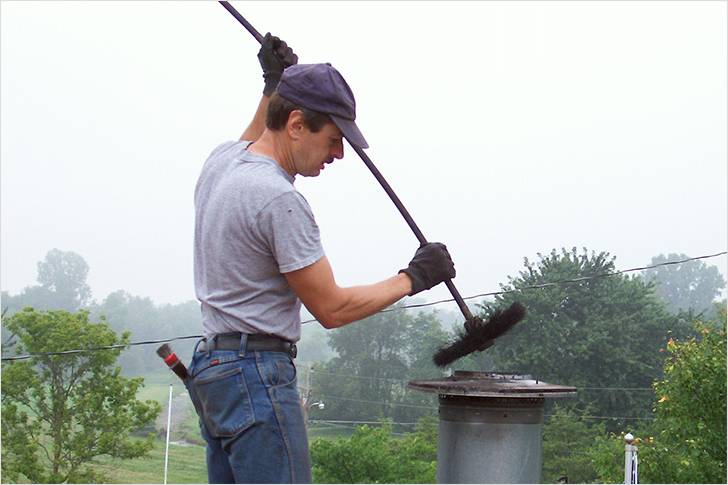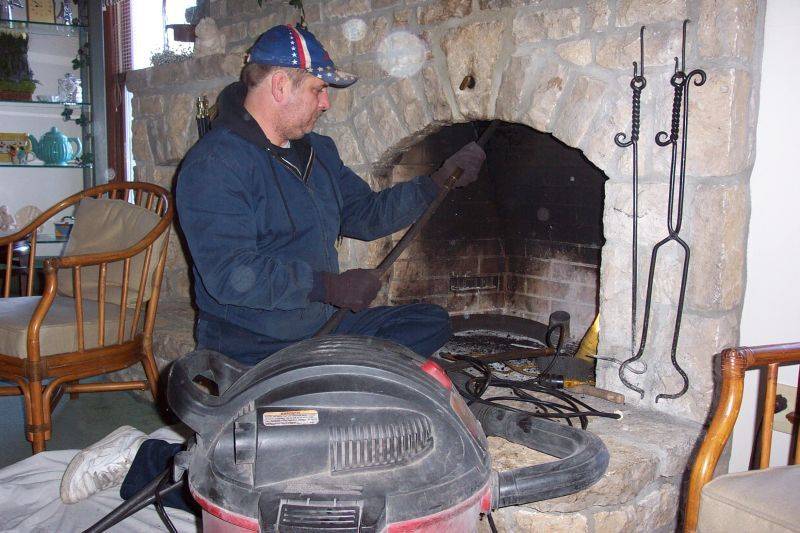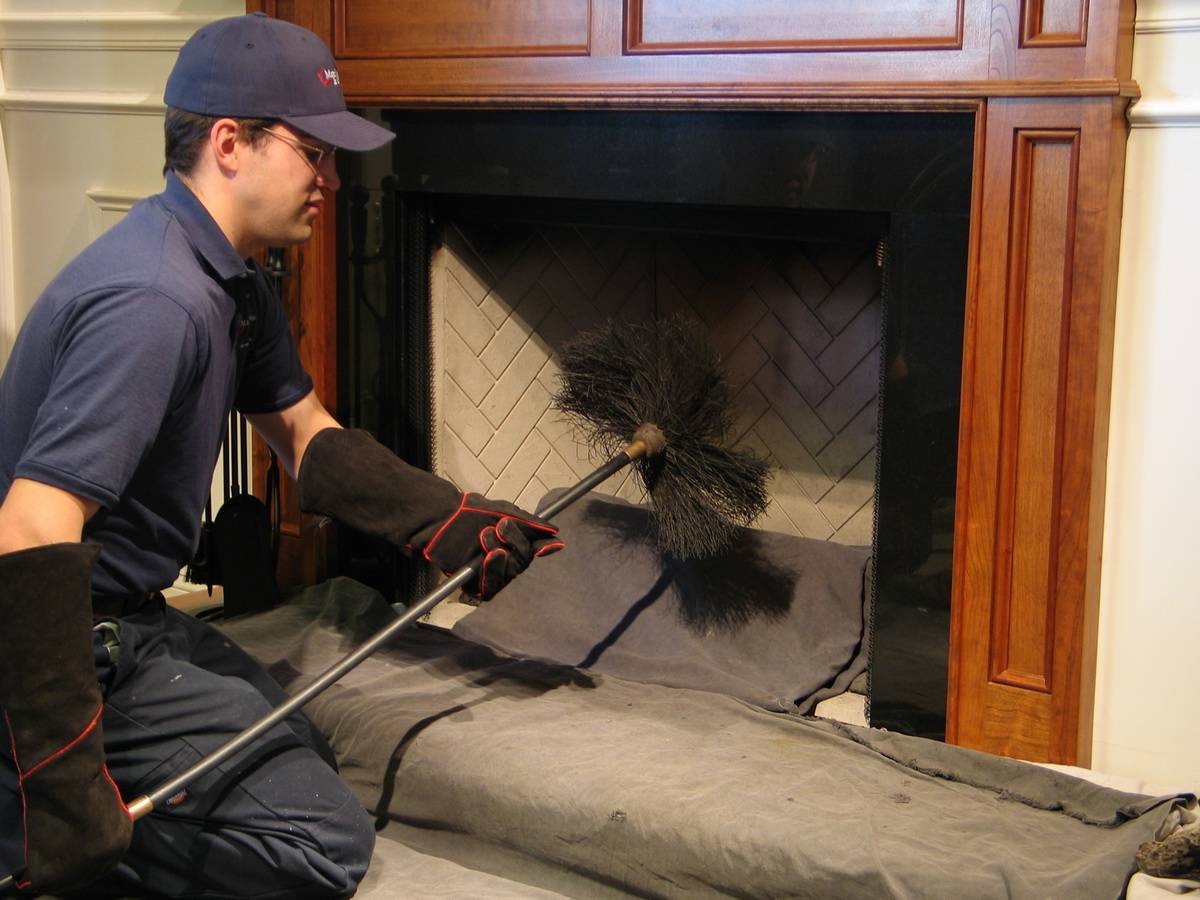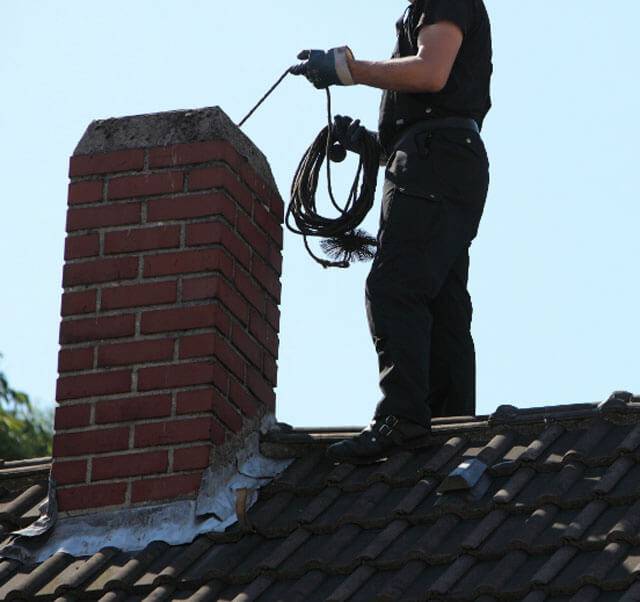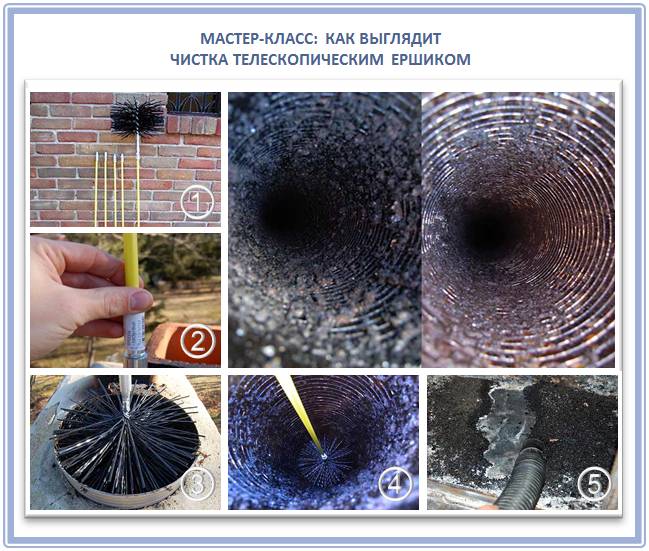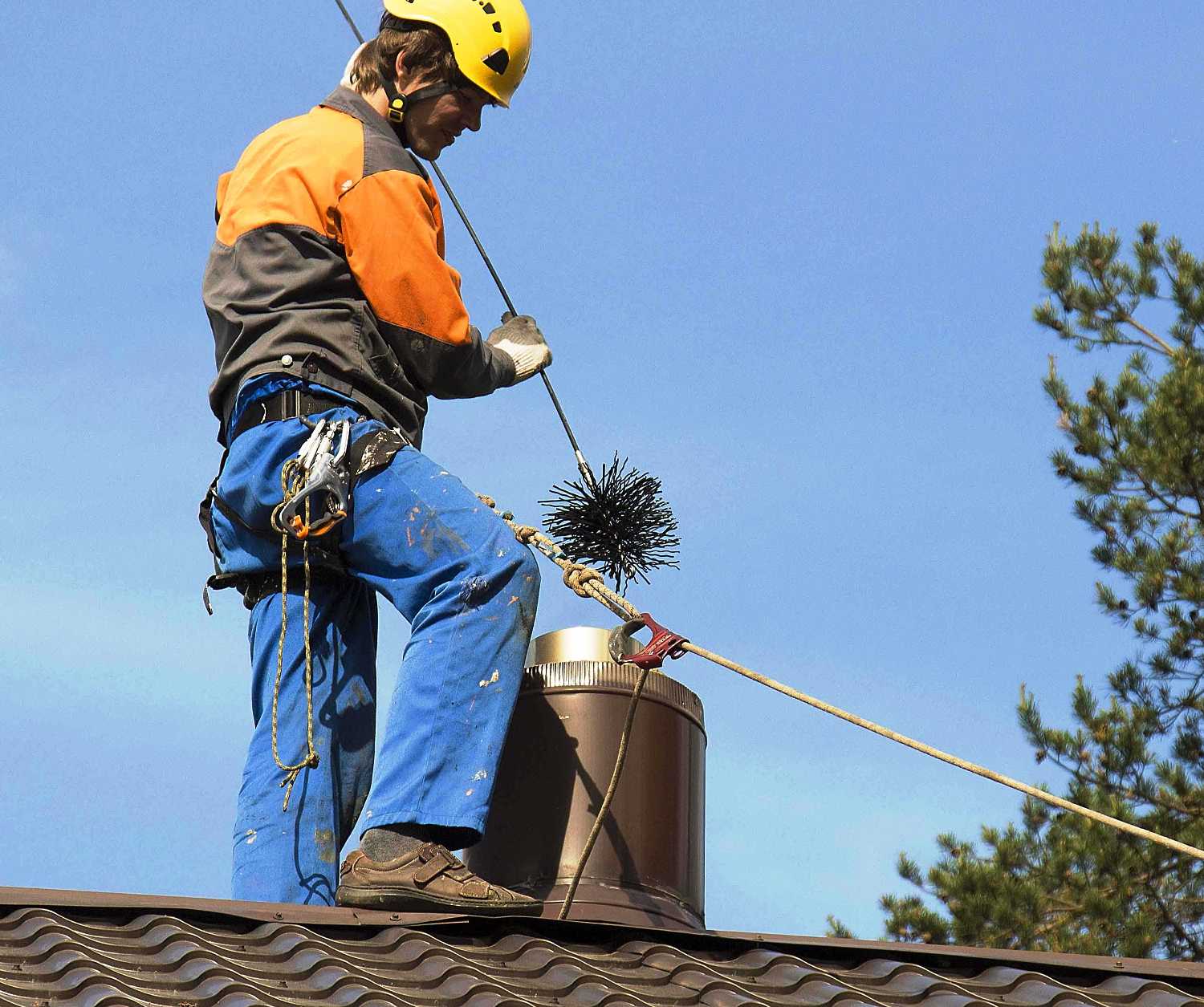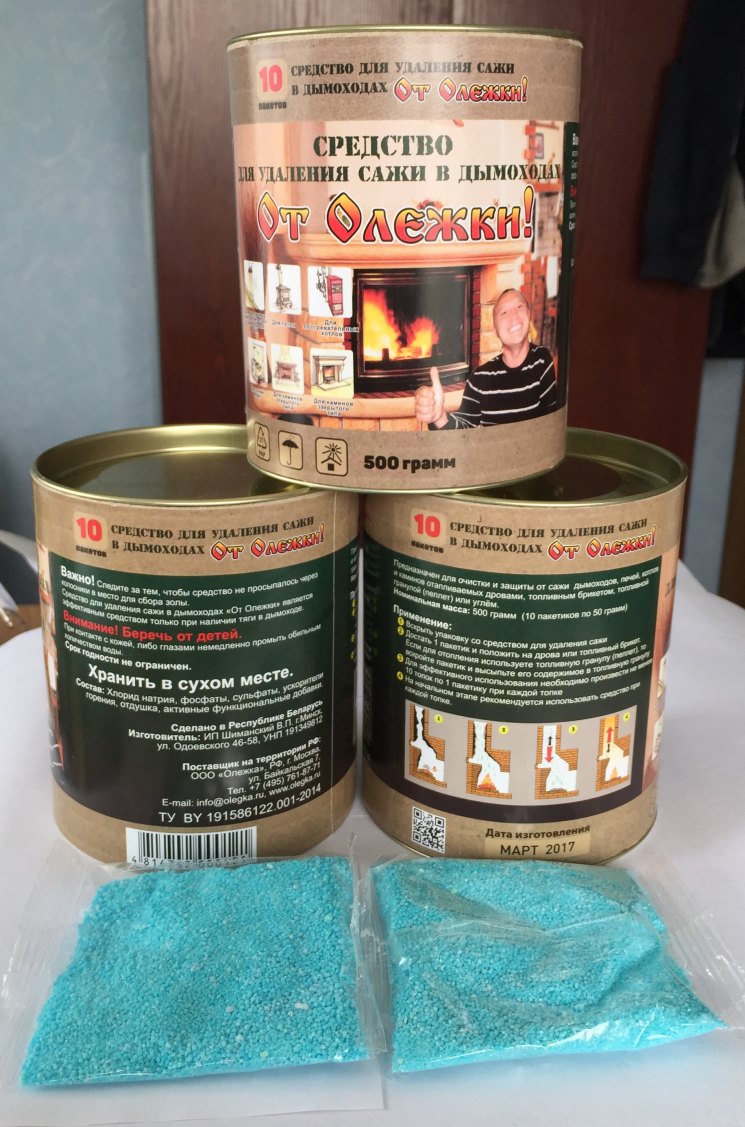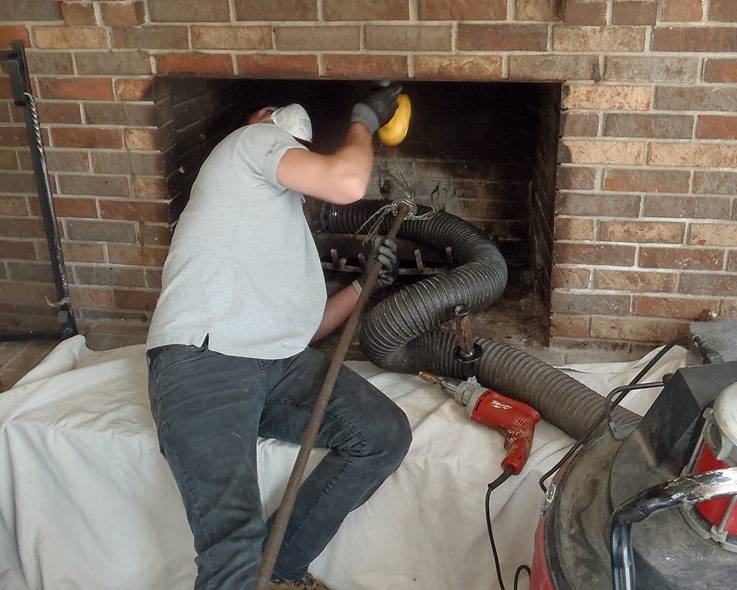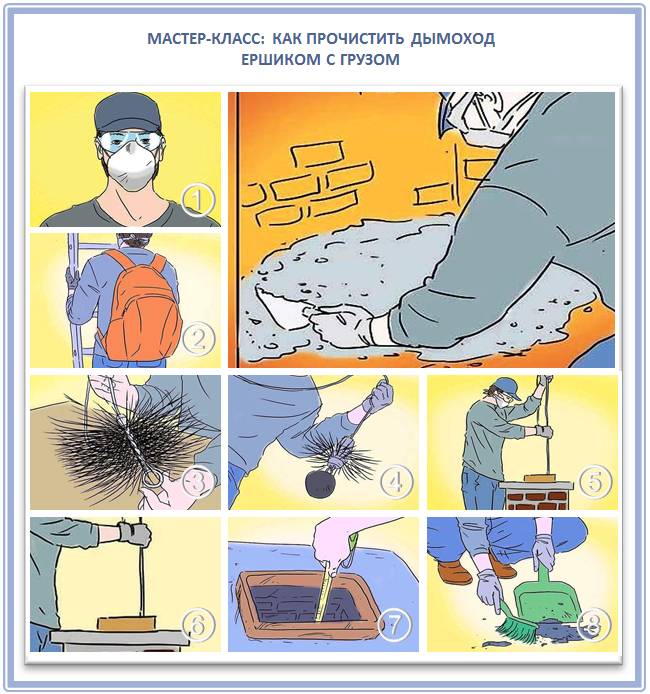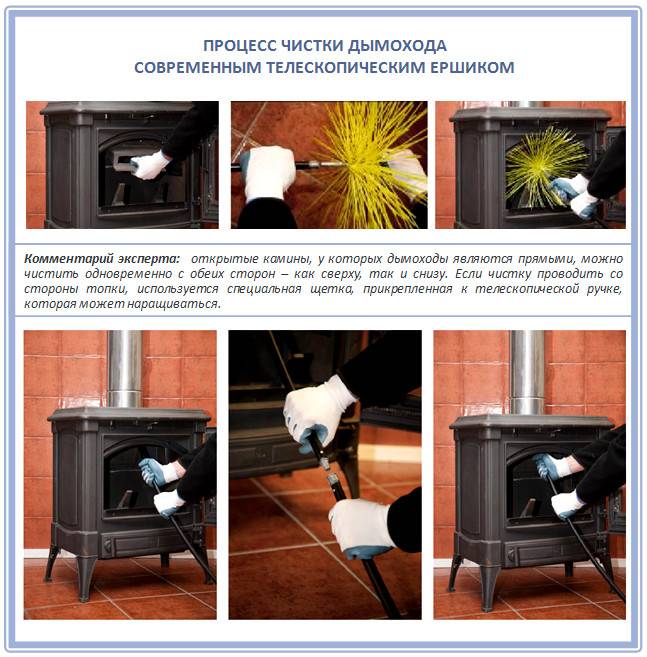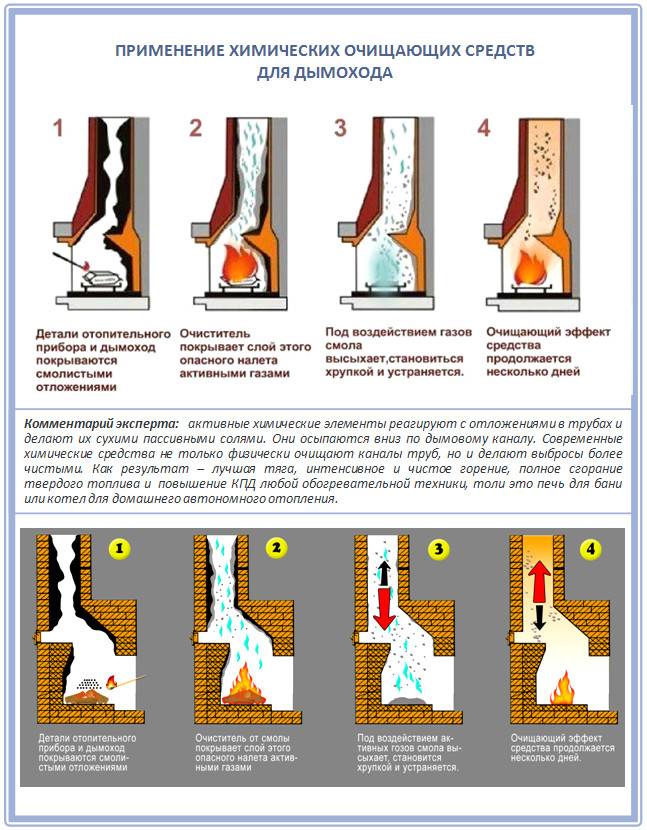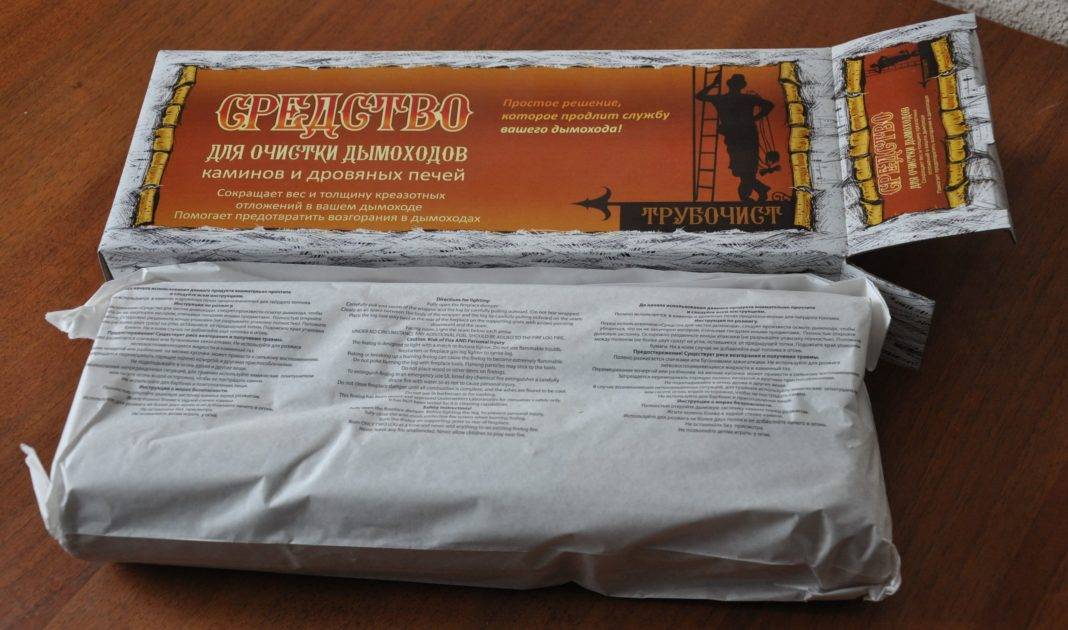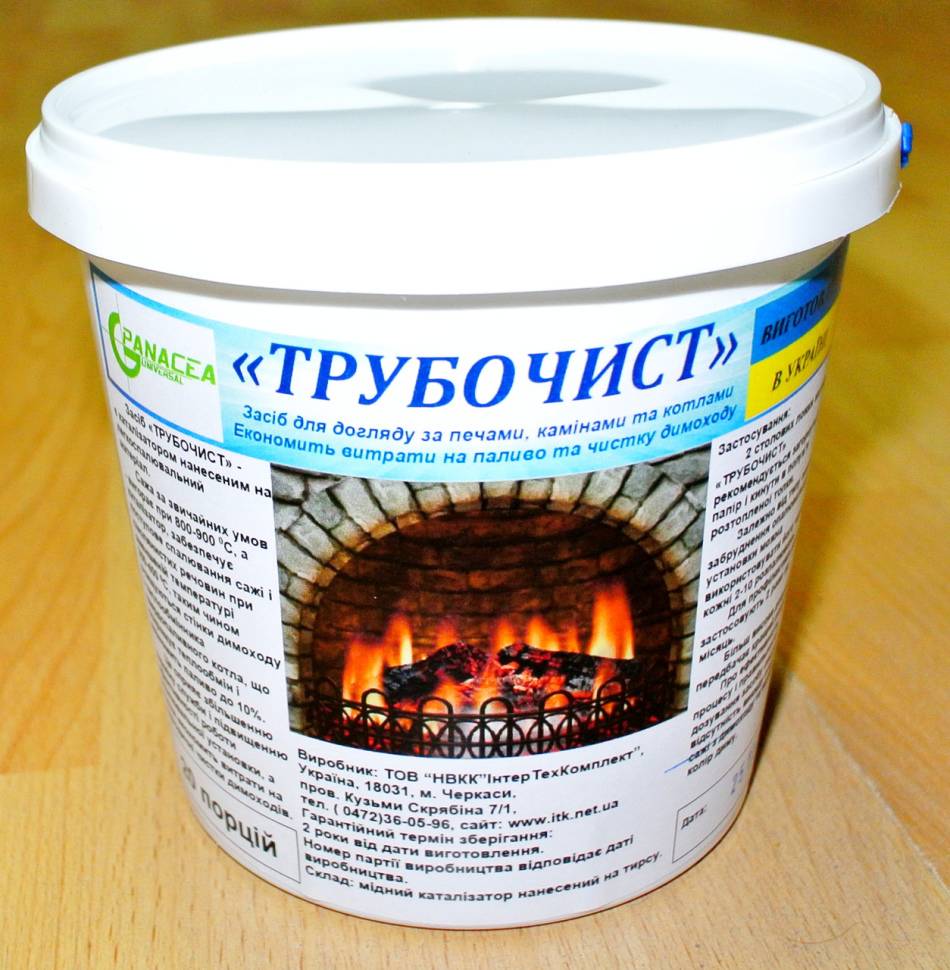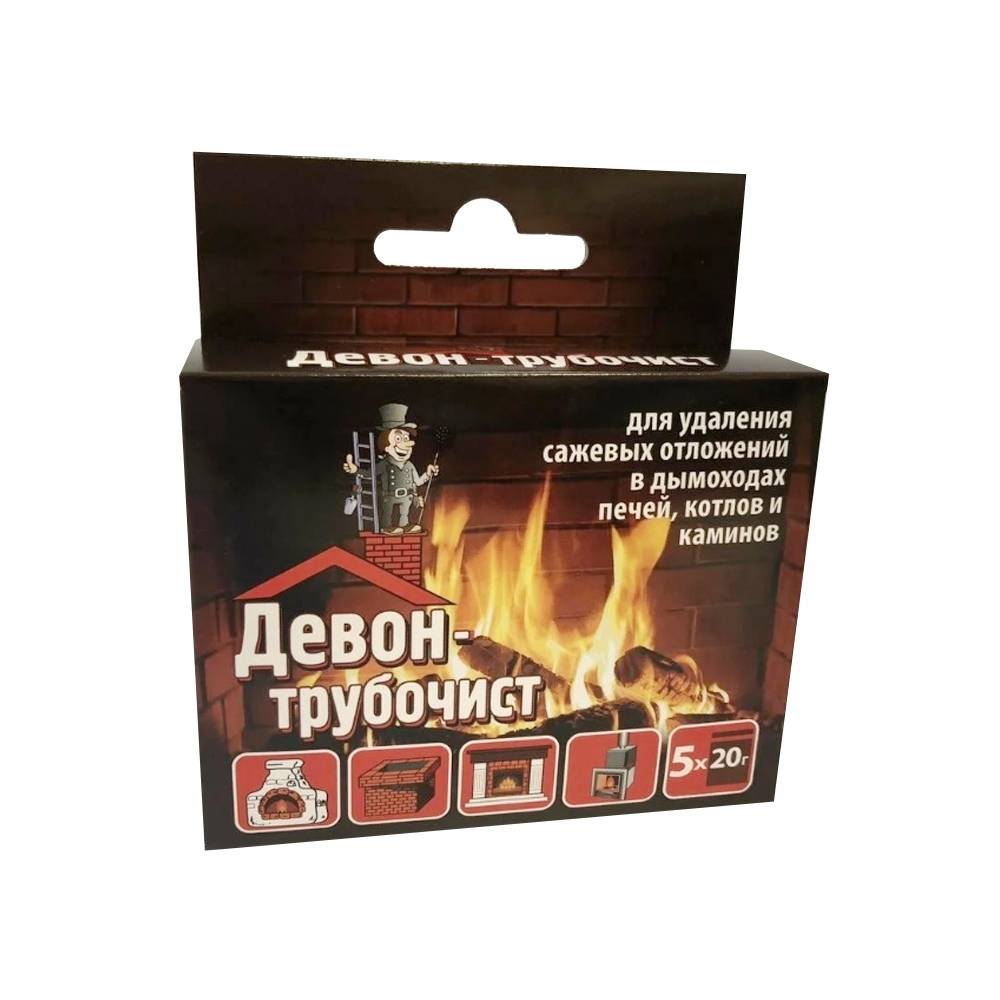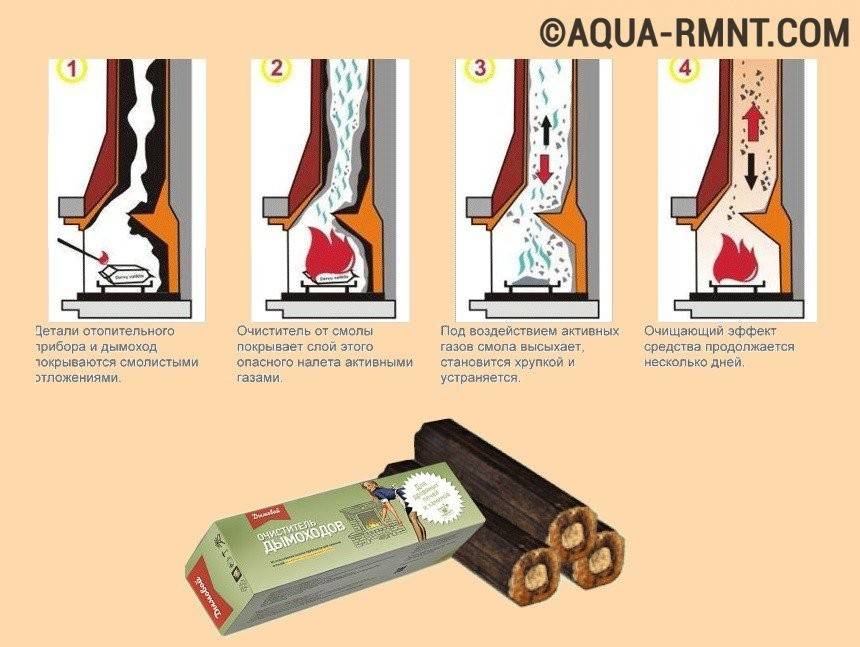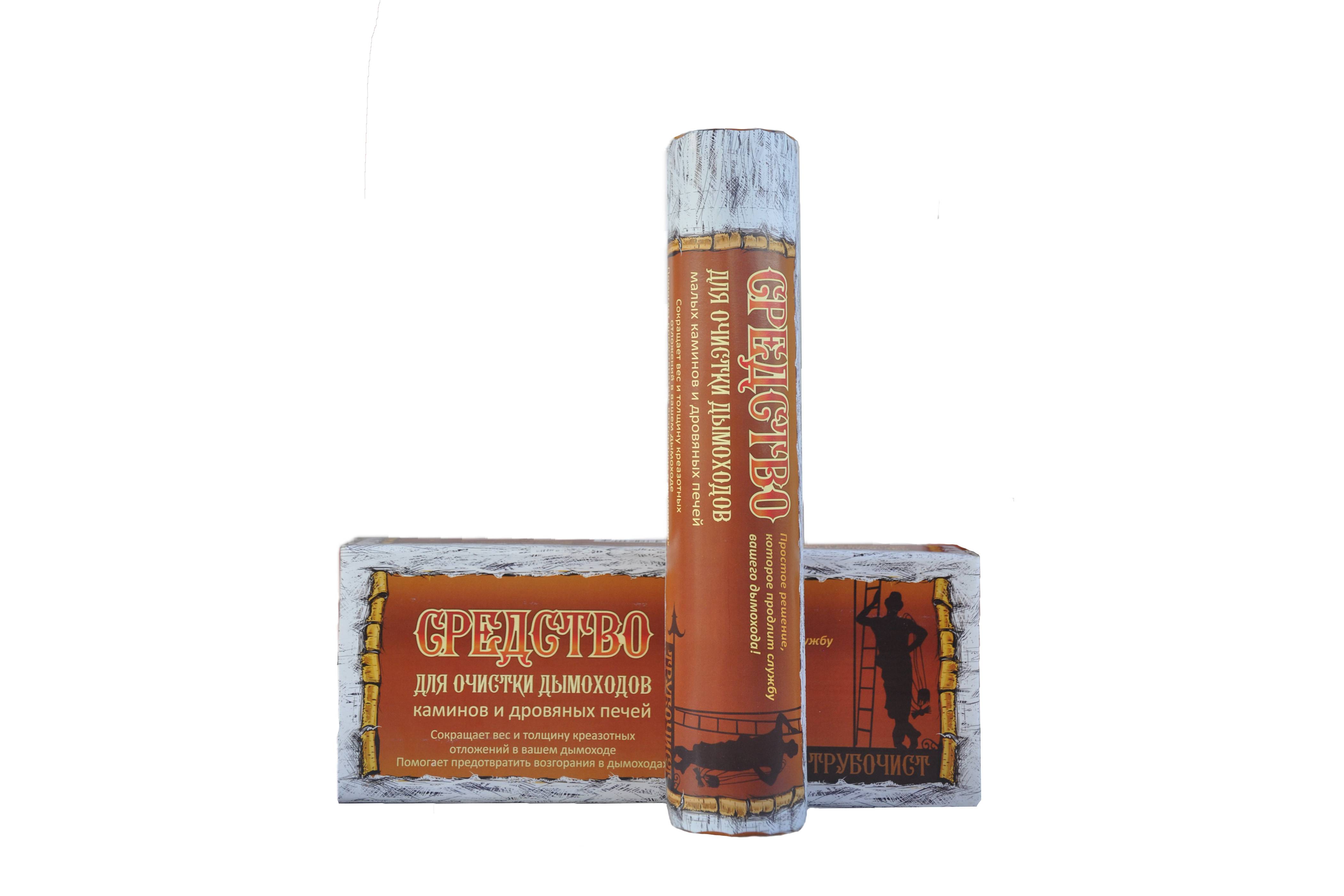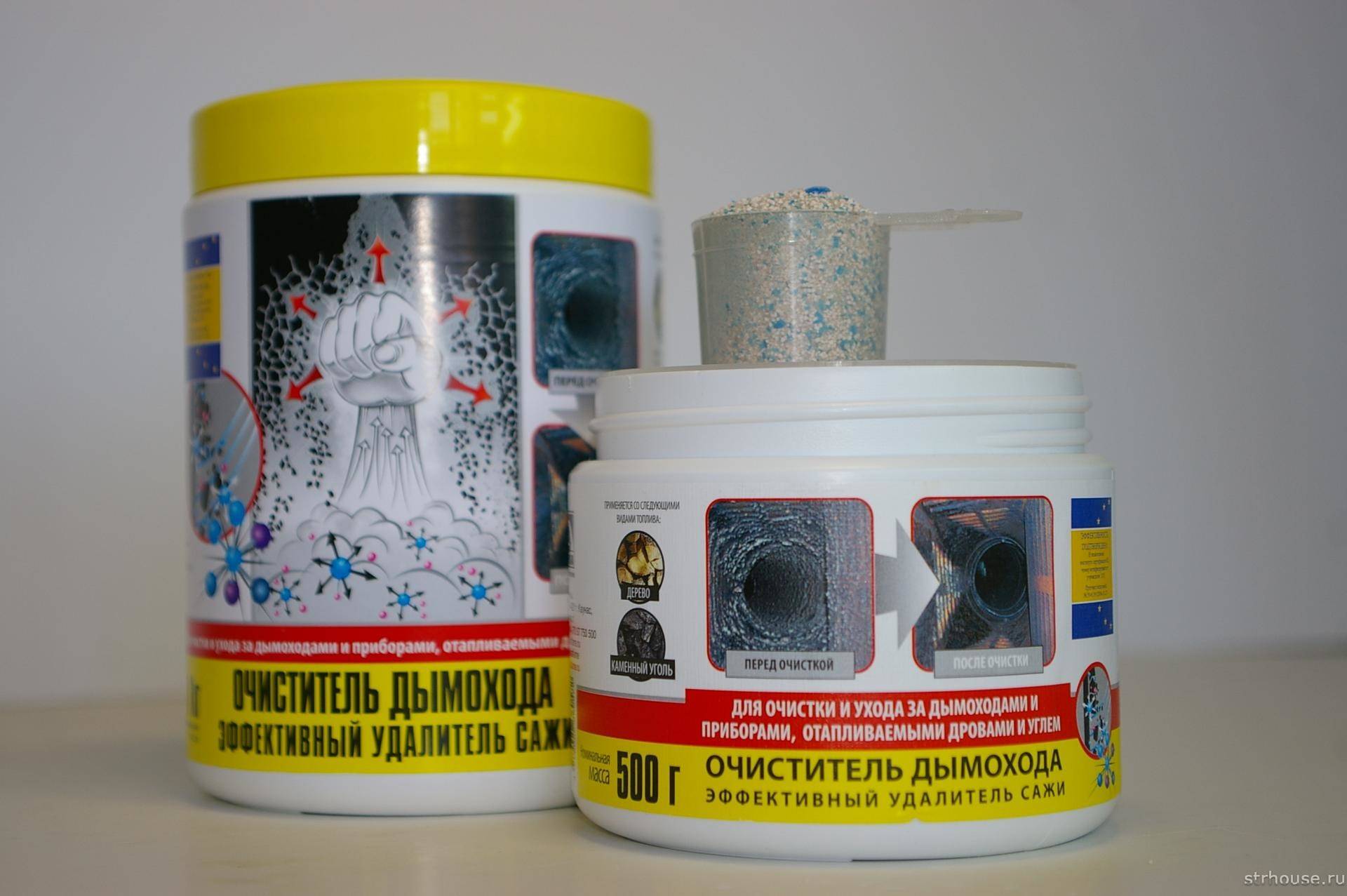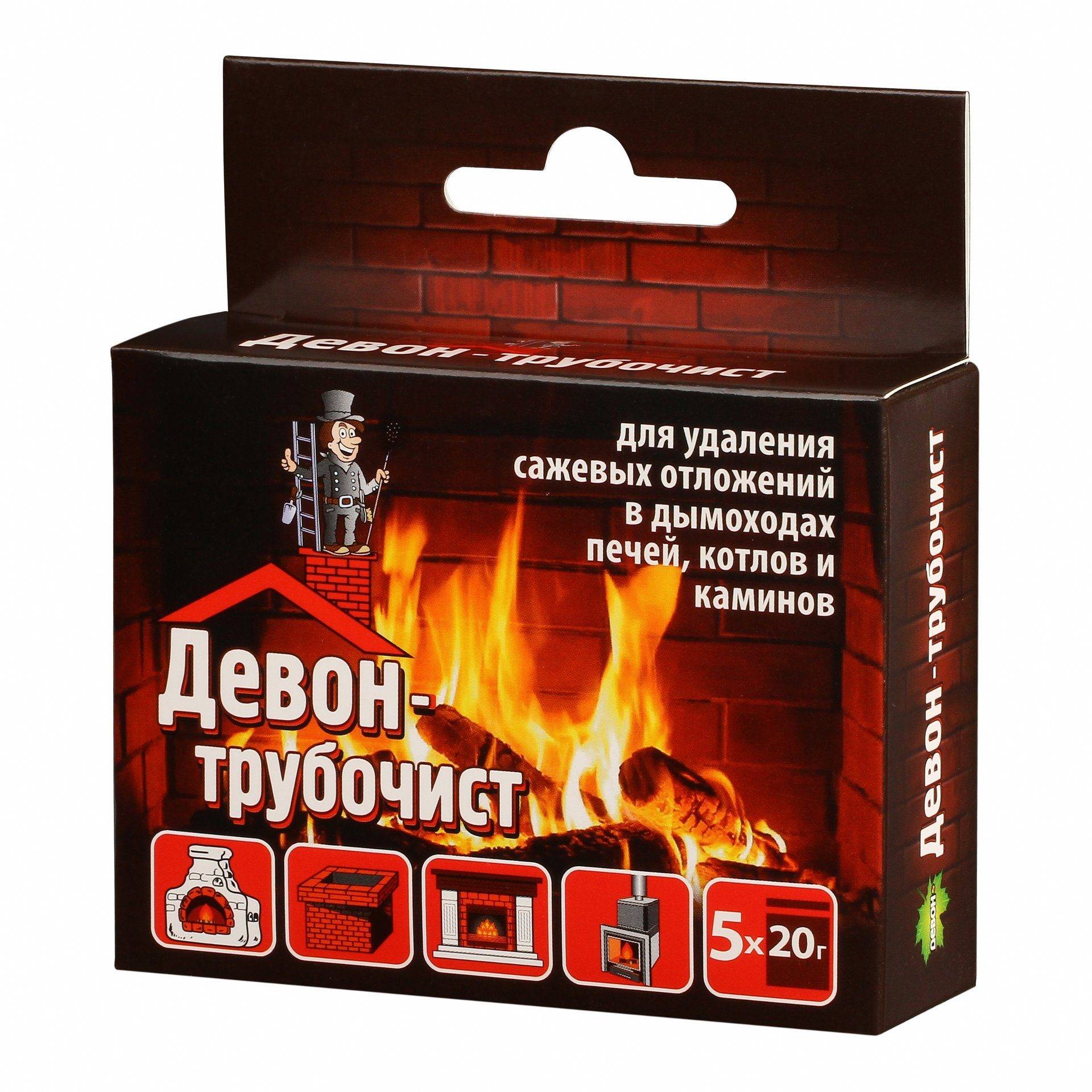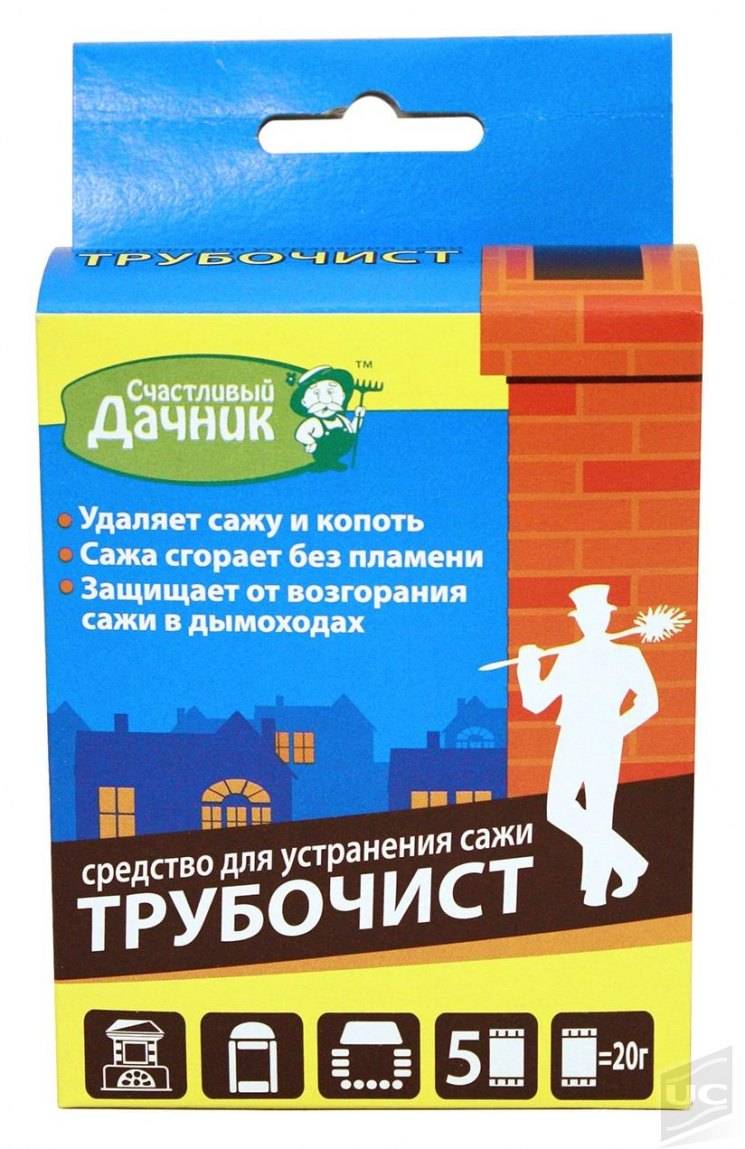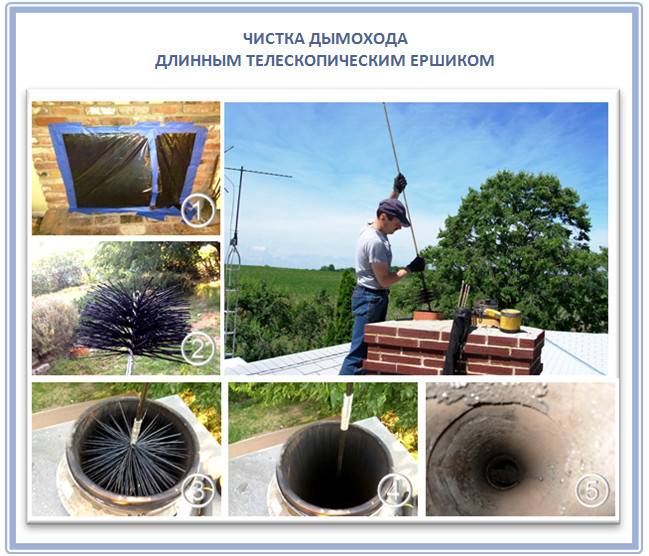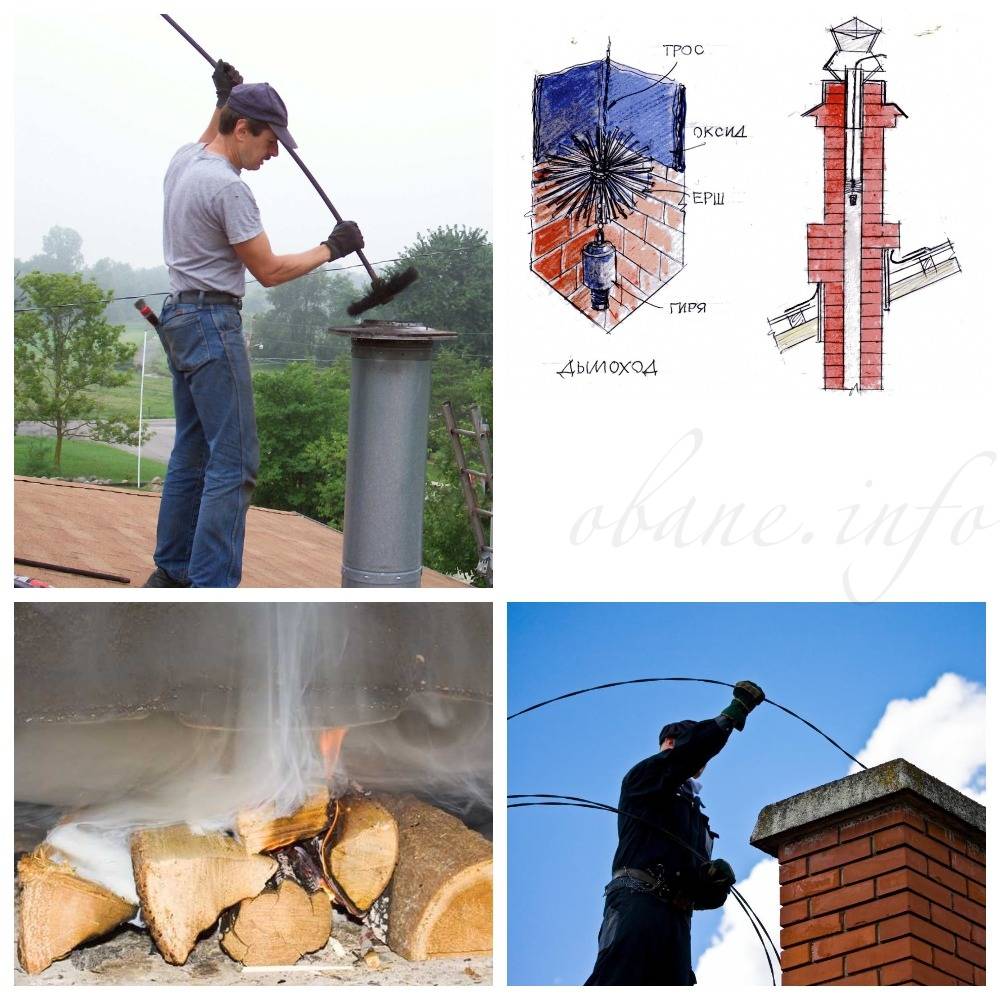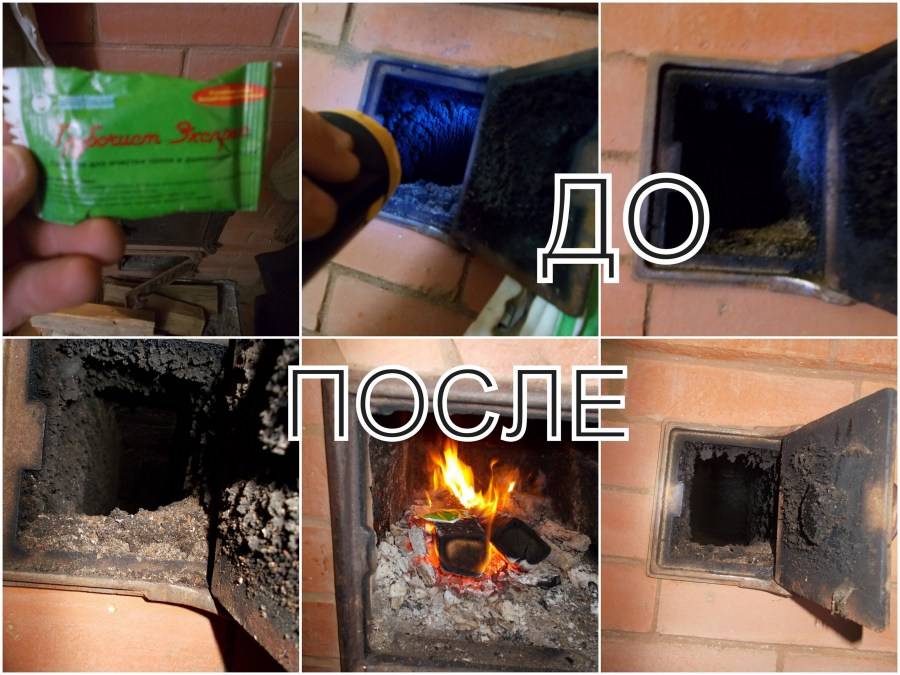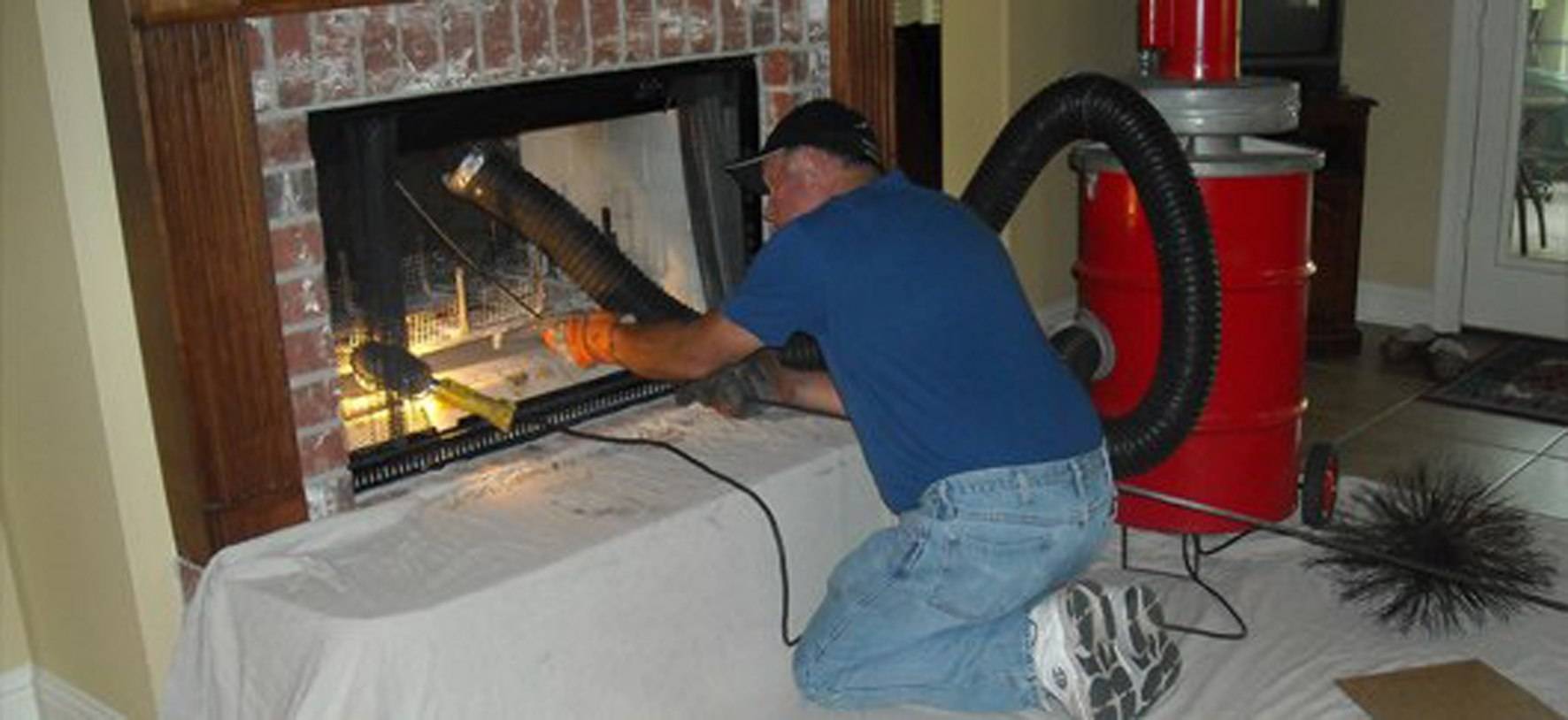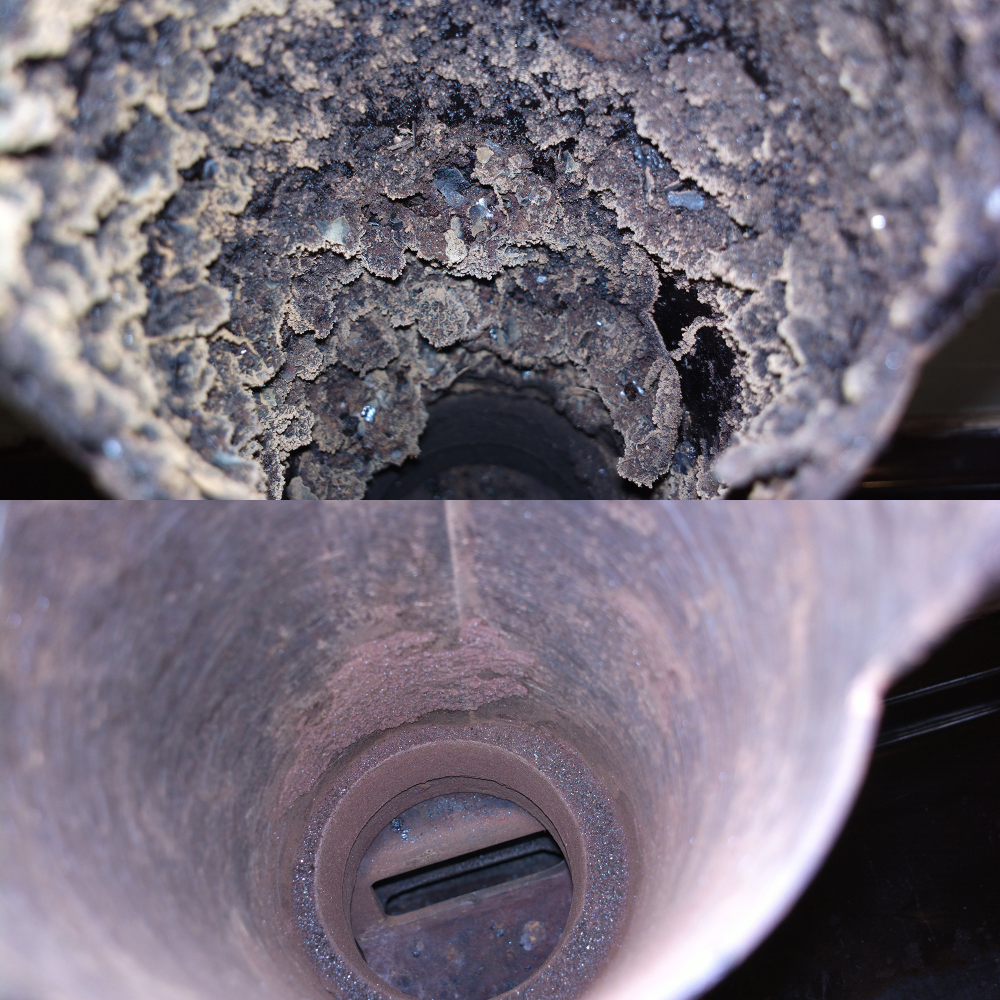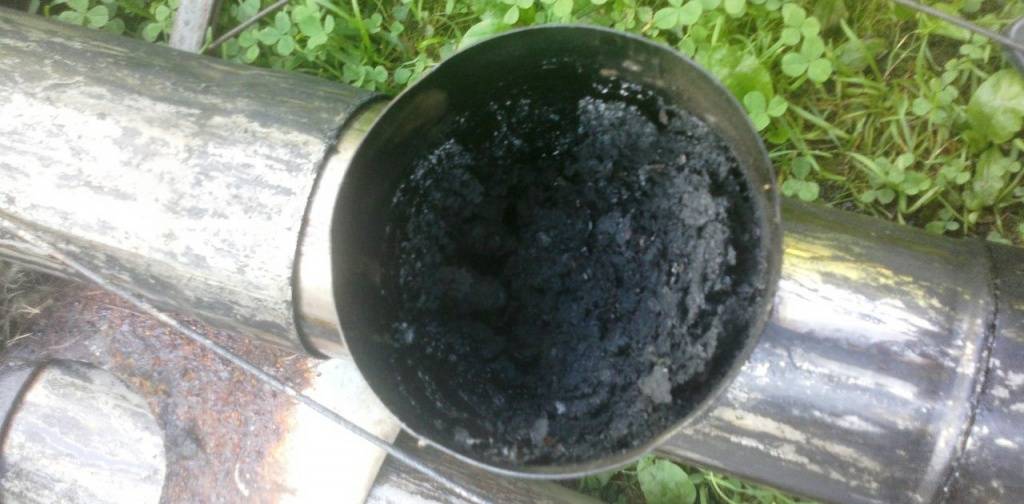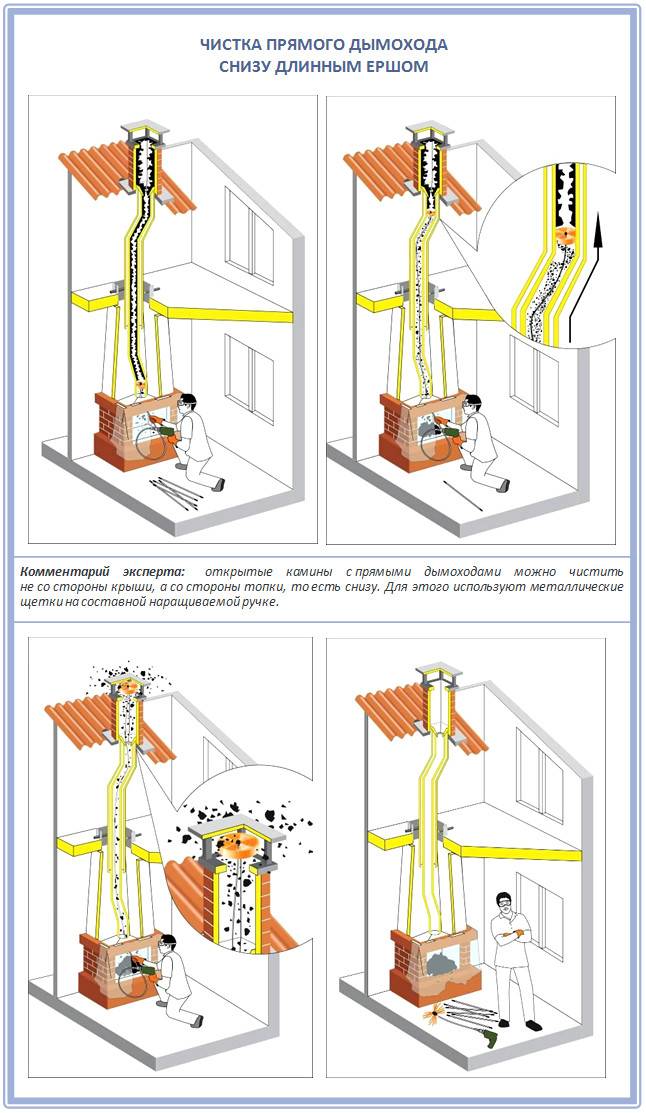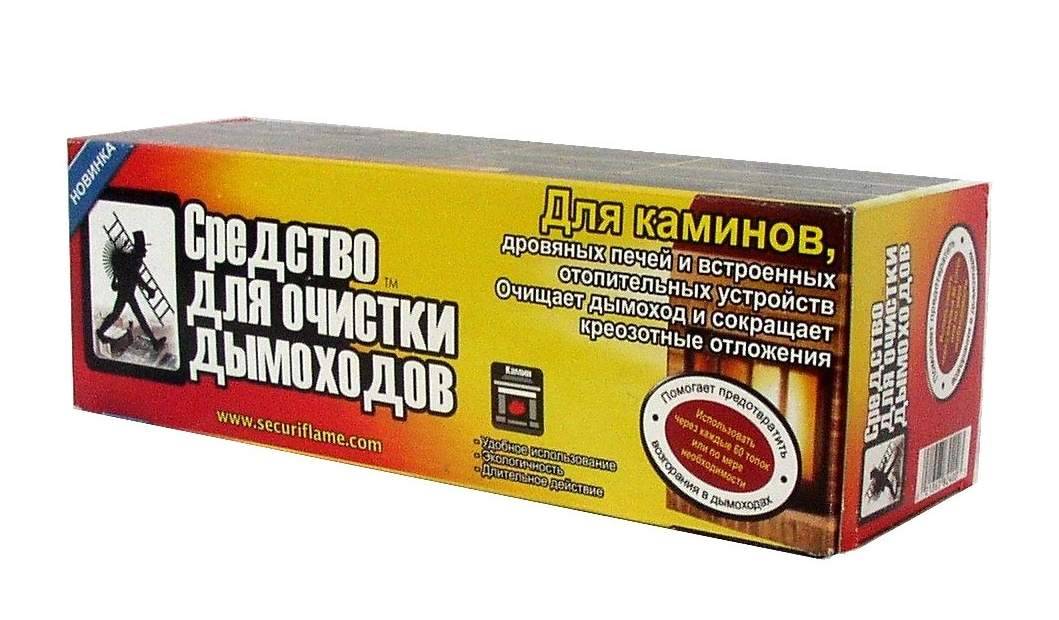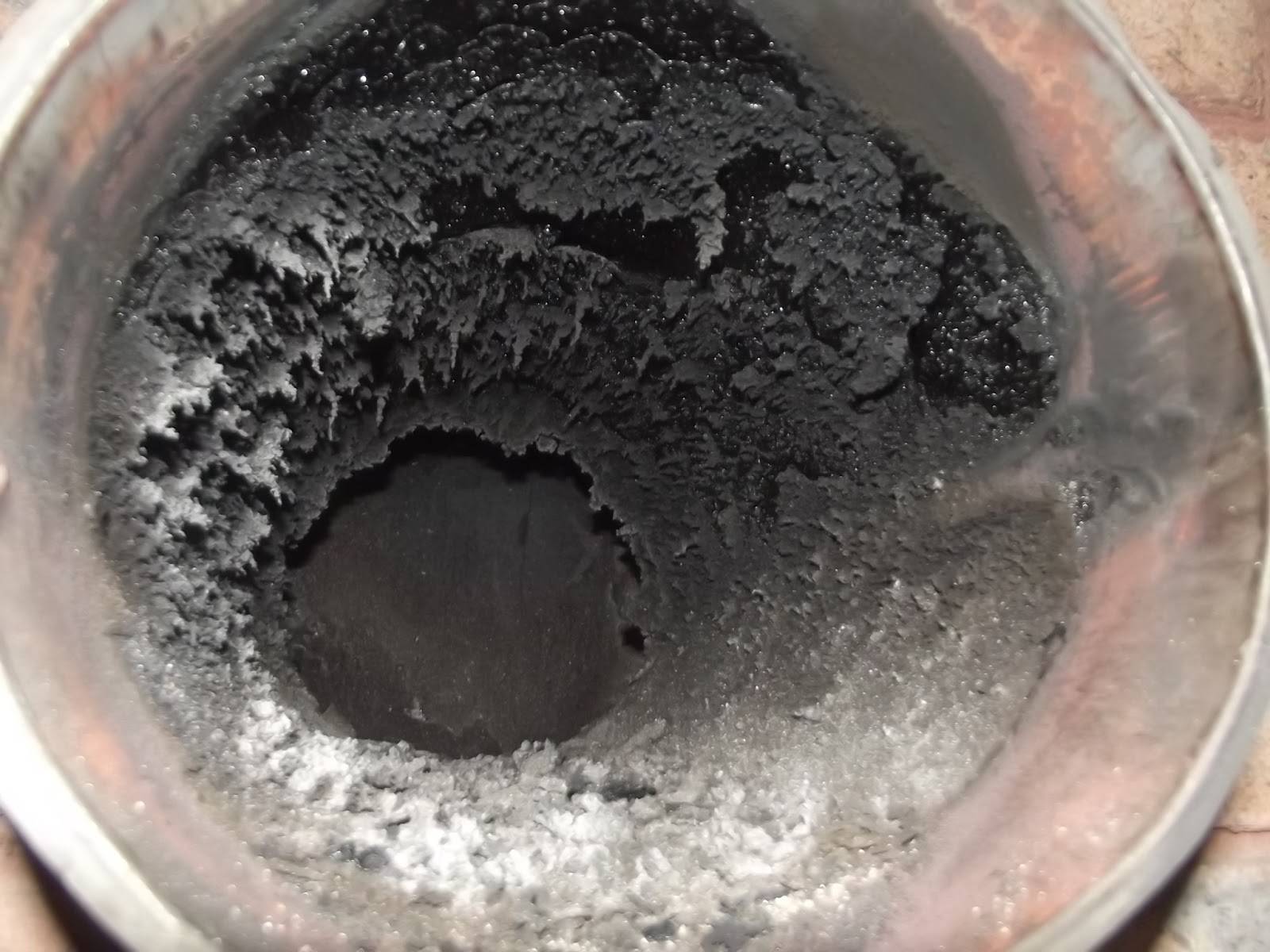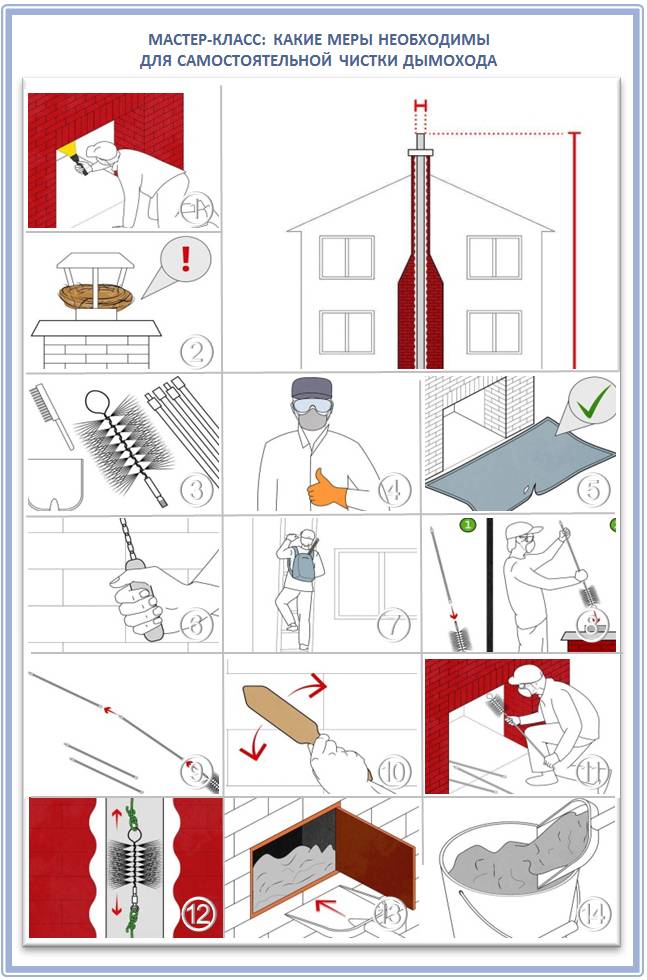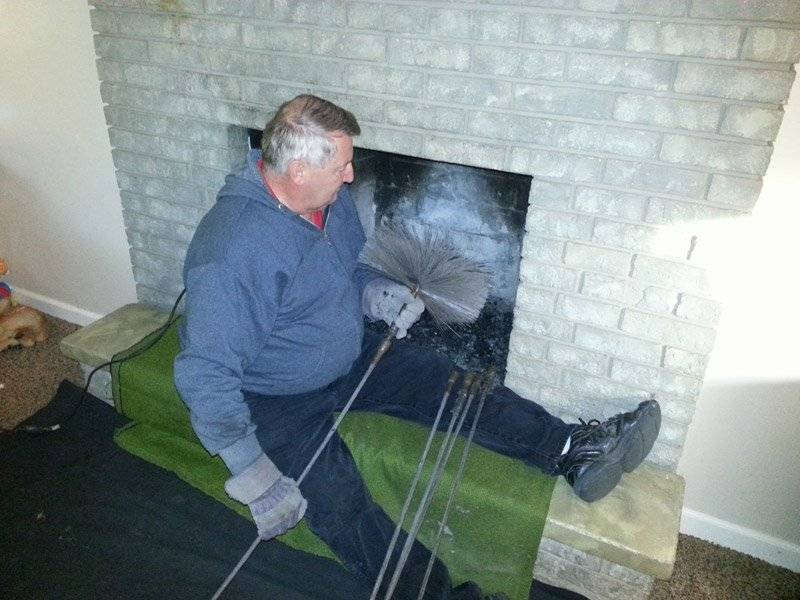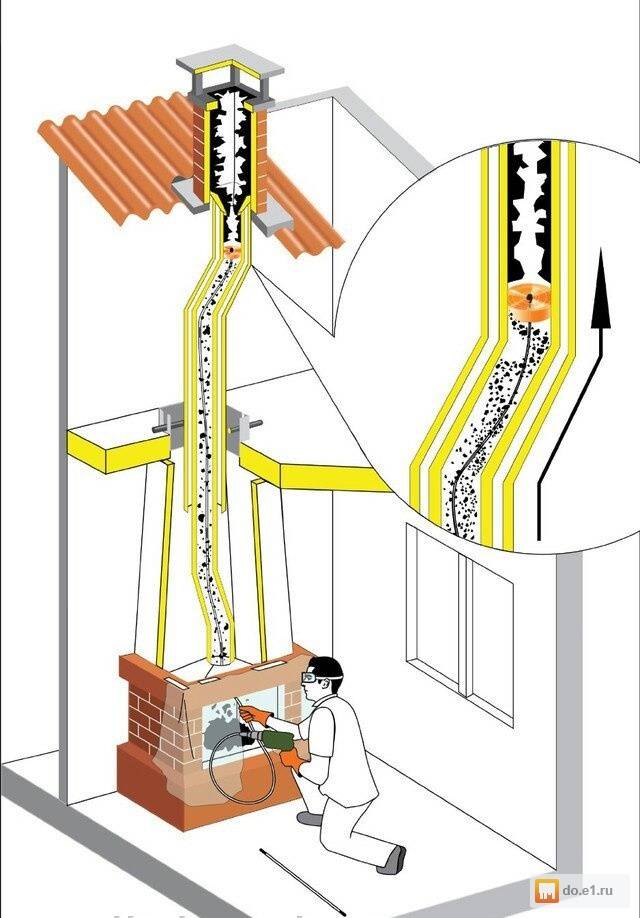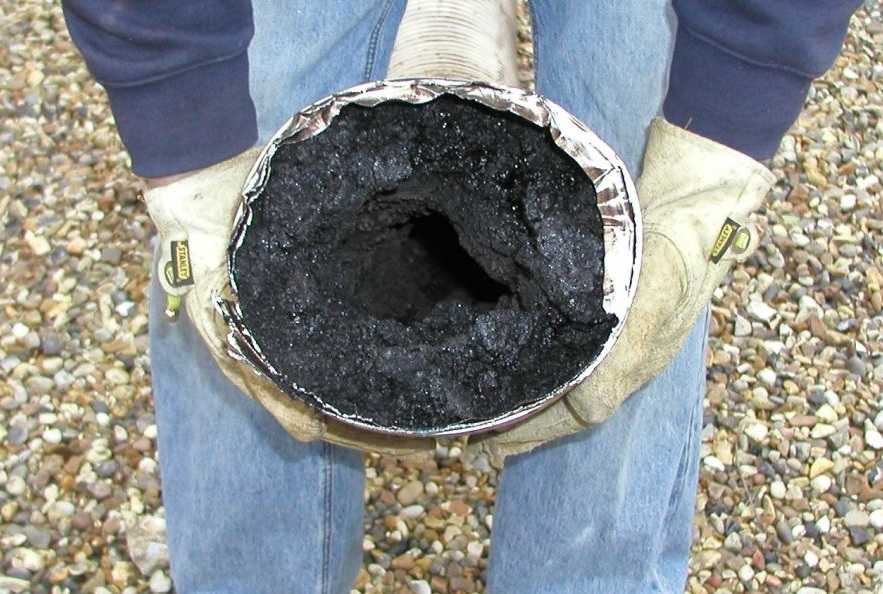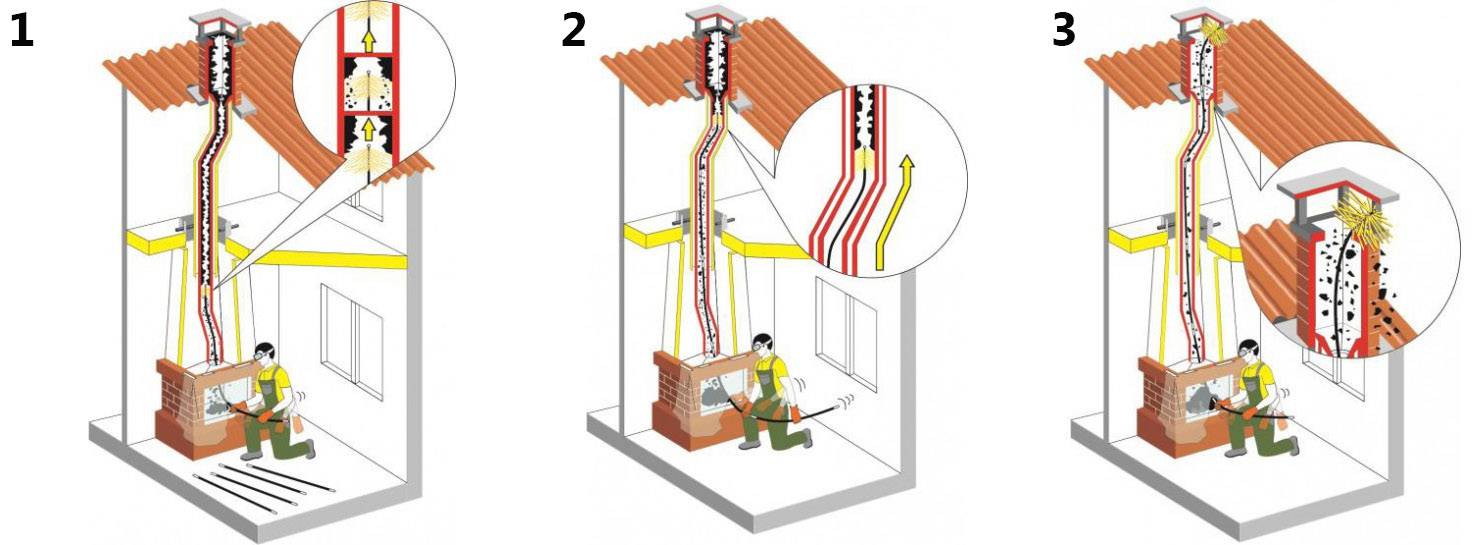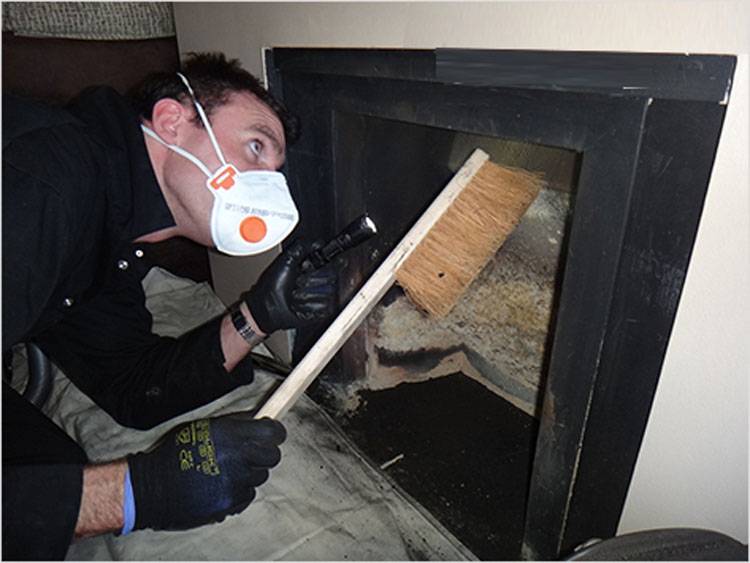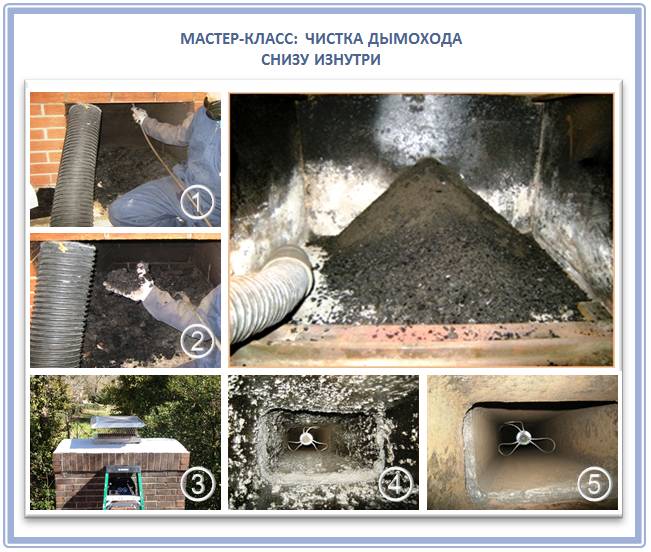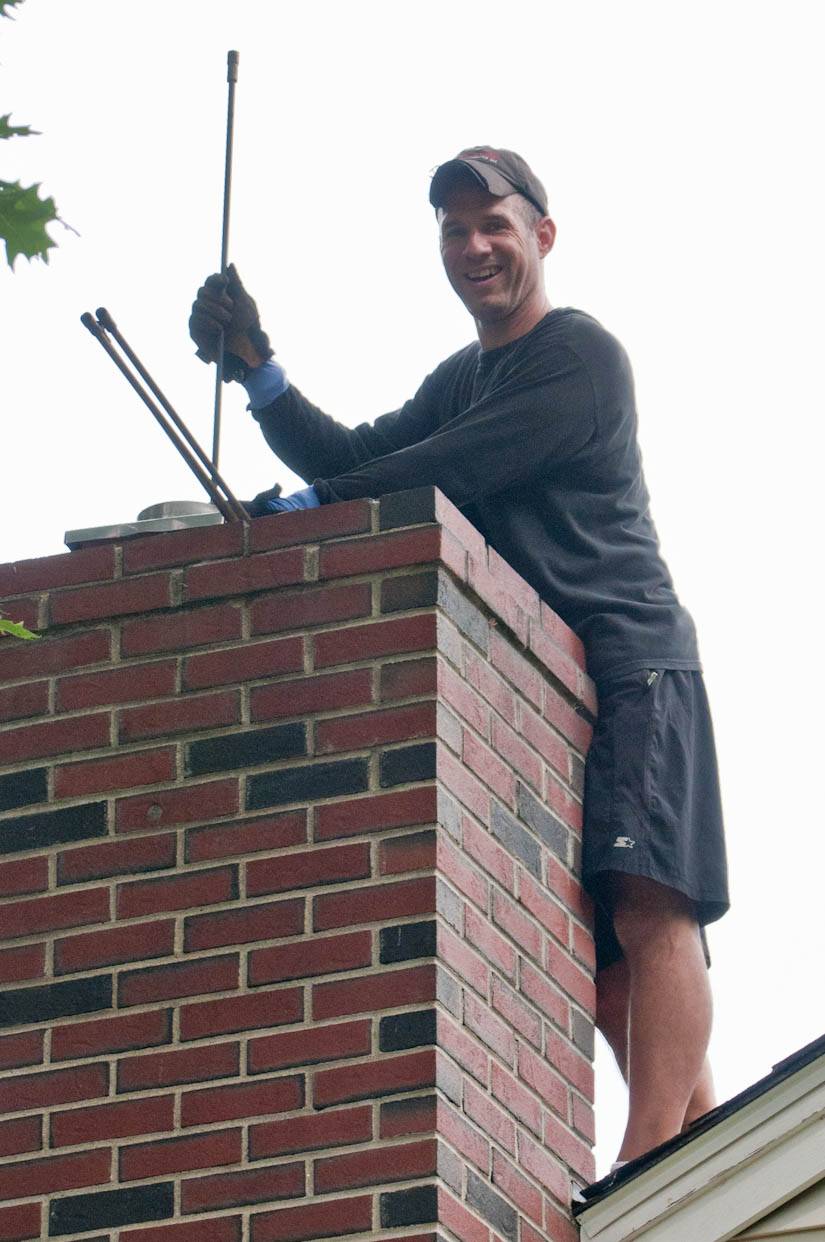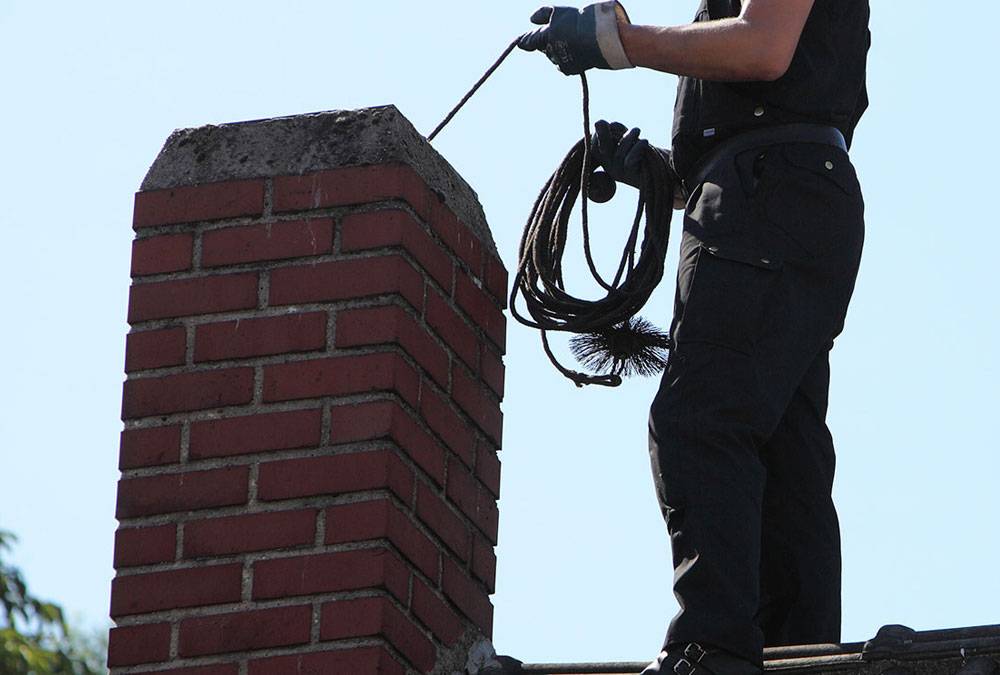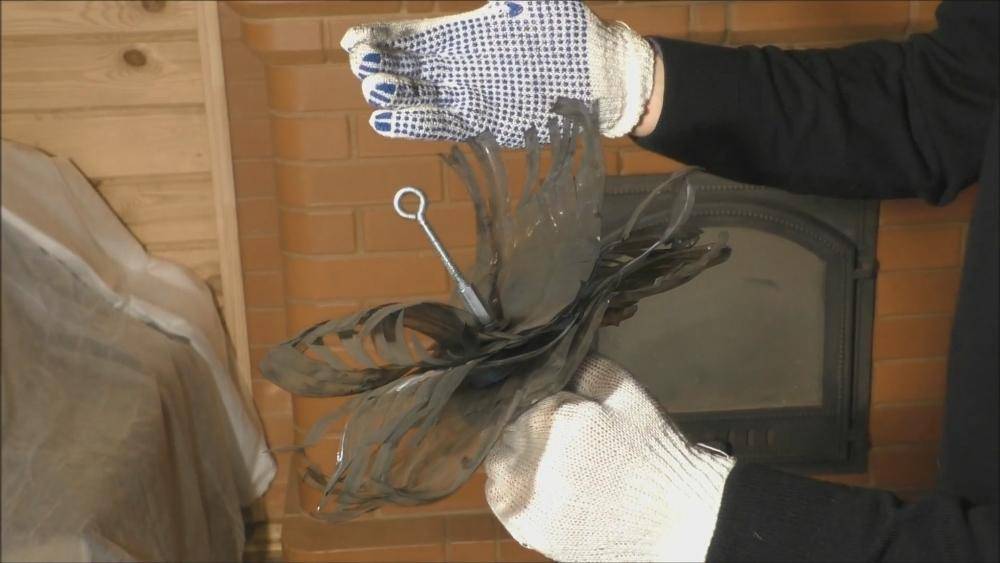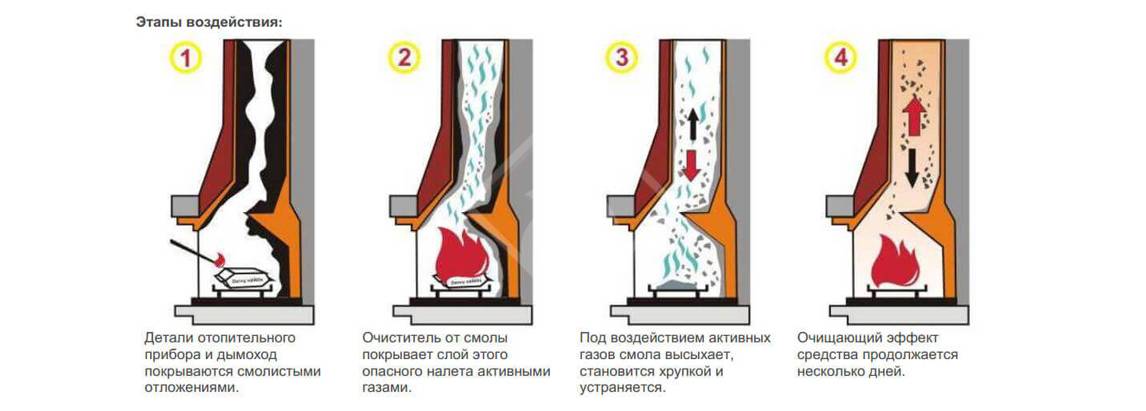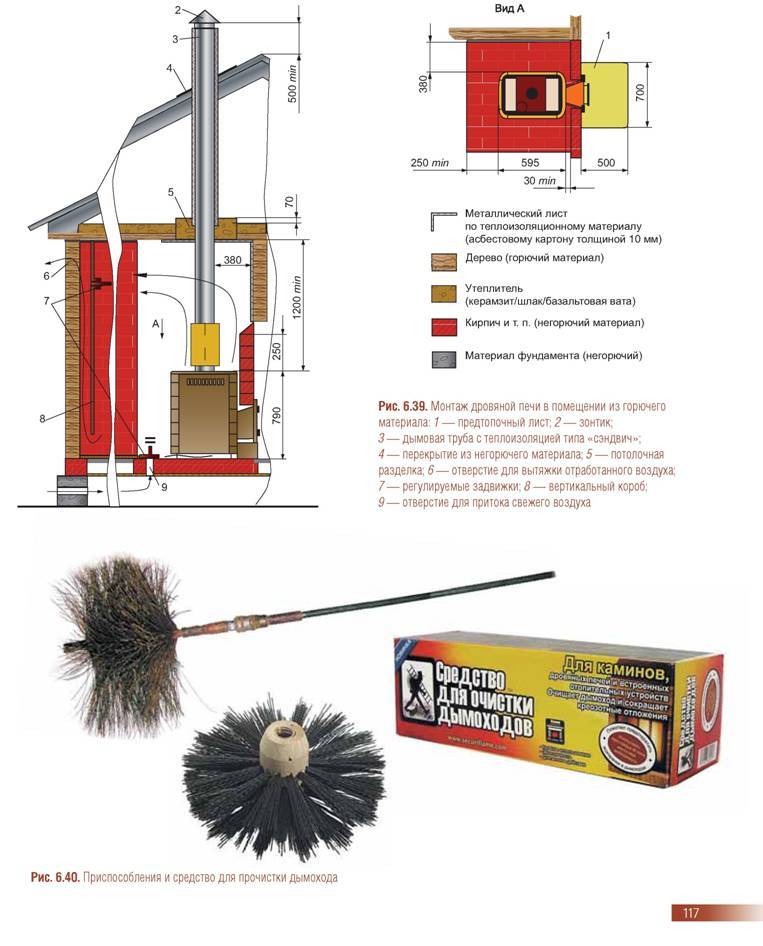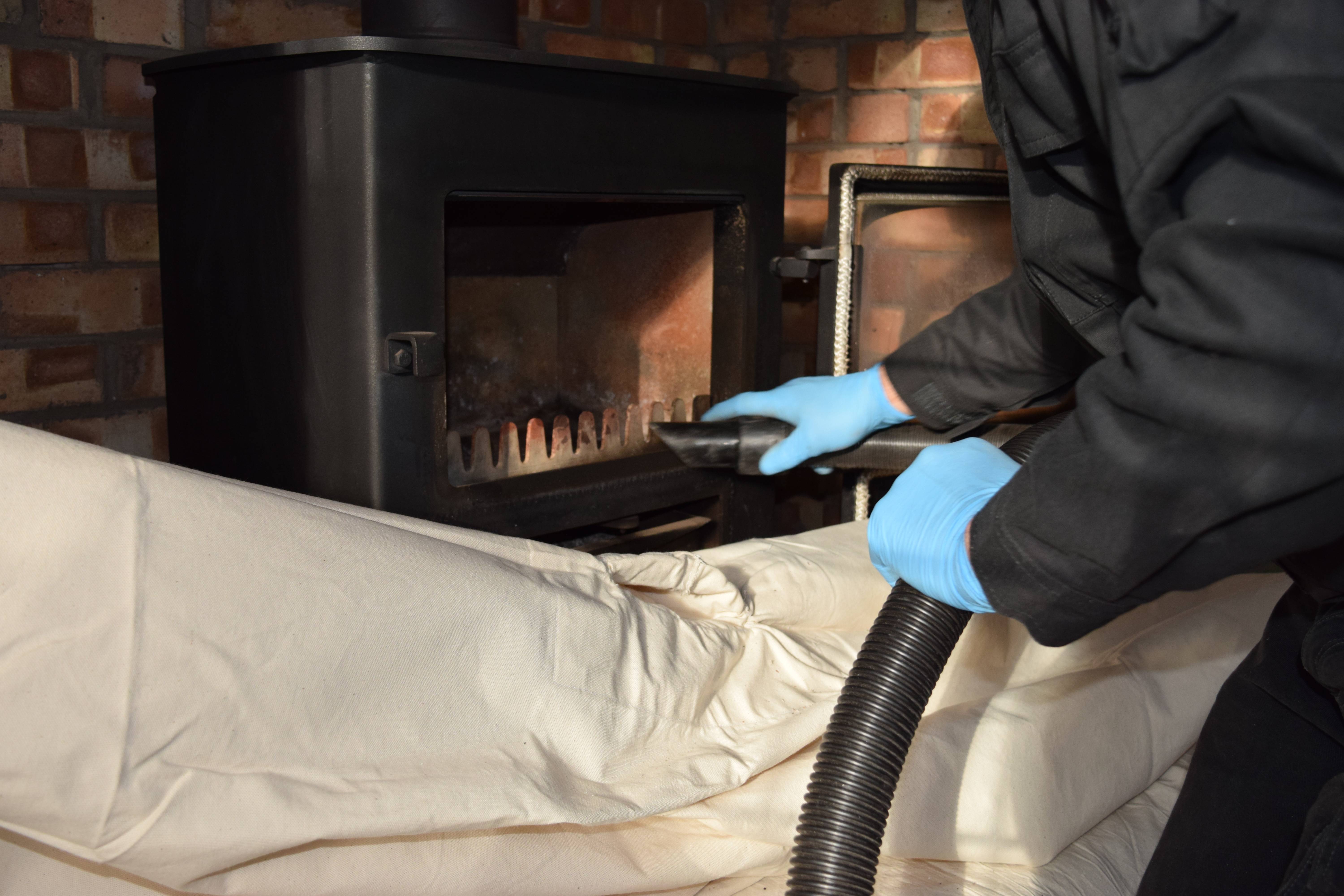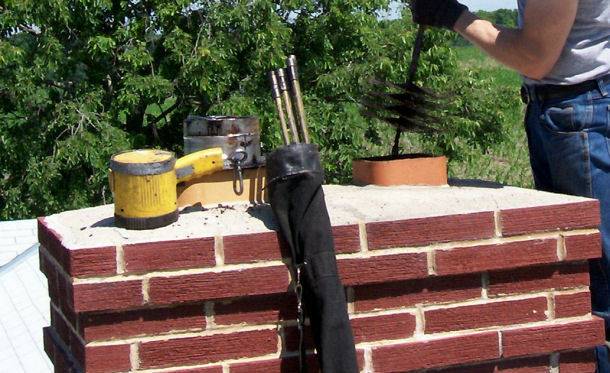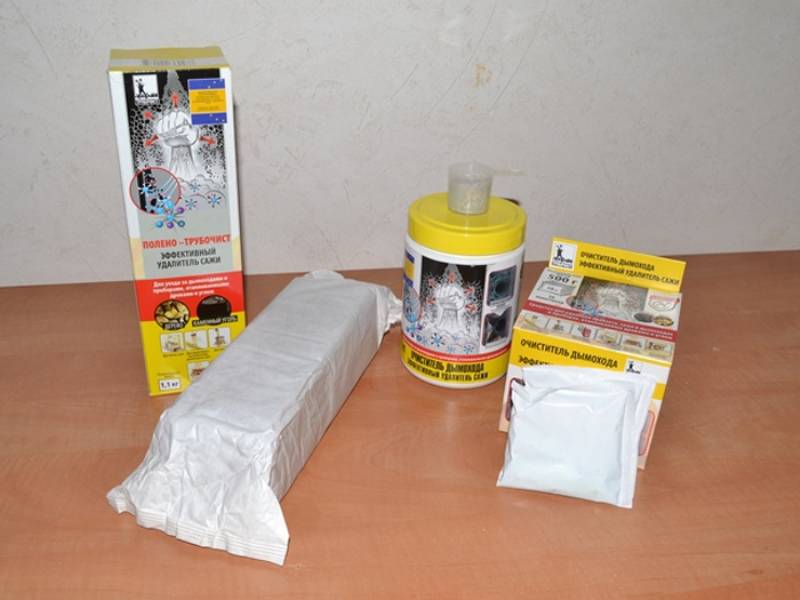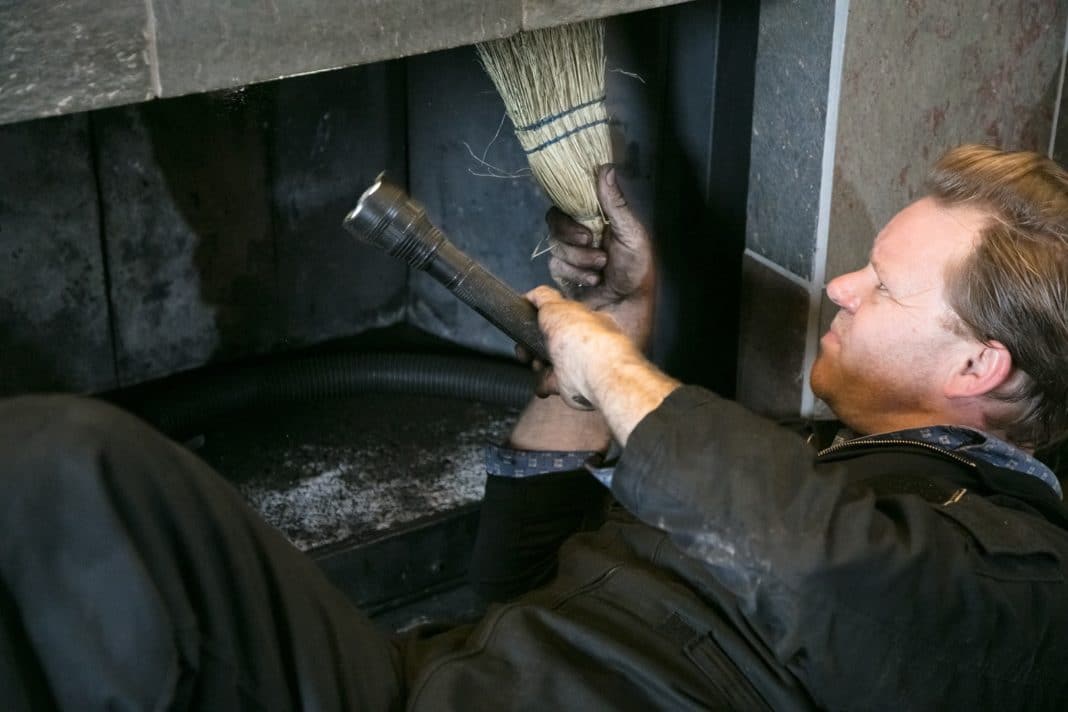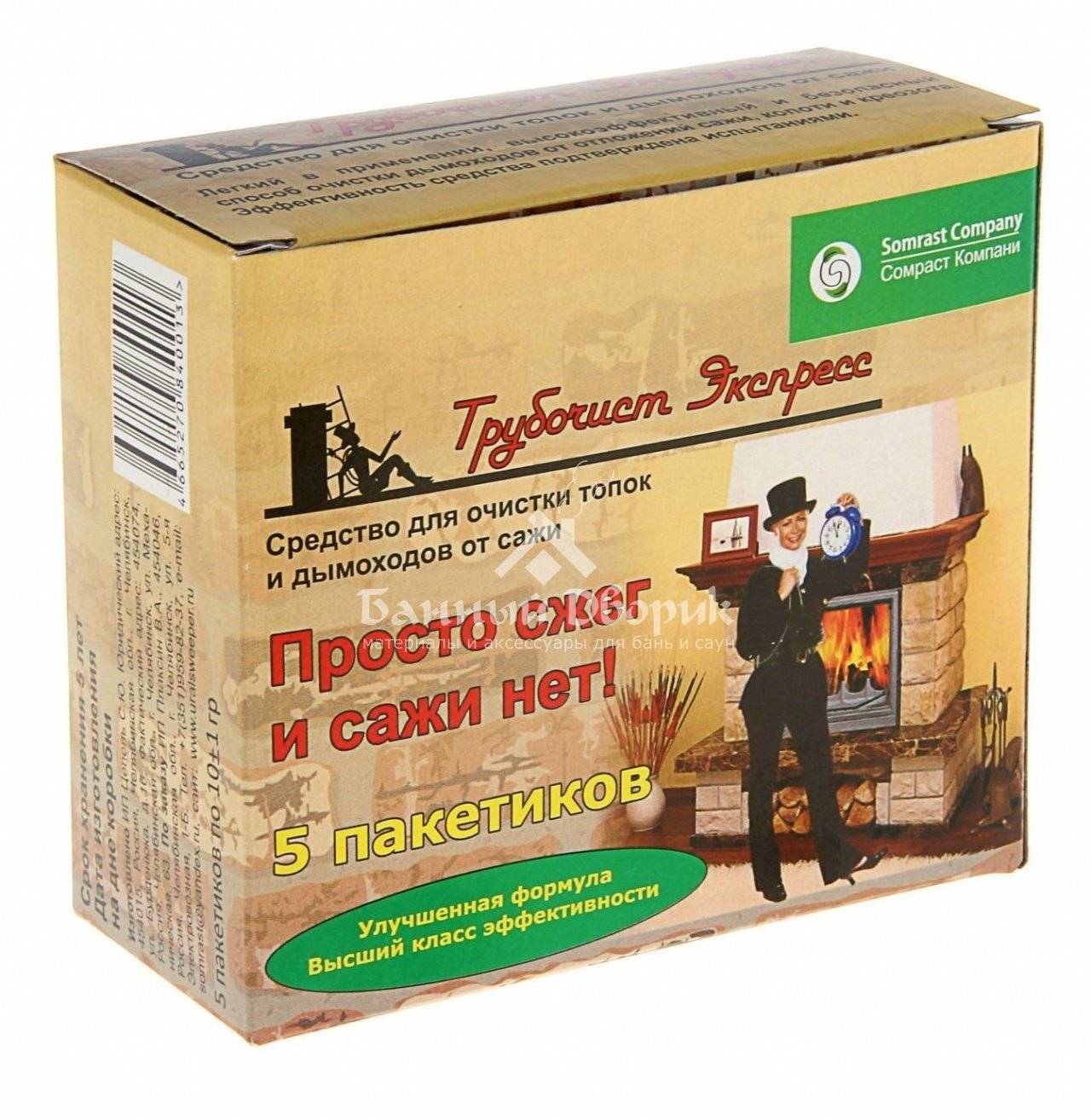Why does the chimney need to be cleaned at all?
When the logs crackle merrily in the fireplace, it seems to us that they burn out completely, leaving behind only a handful of ash in the firebox and carrying light smoke into the chimney. But this is far from the case: the combustion conditions in the stove and fireplace do not allow the wood to burn out completely, and soot is carried away into the chimney along with the smoke. It has a gray or black color and is similar in composition to coal. Soot particles settle on the pipe walls, especially at the bends, forming a thick layer of loose deposits.
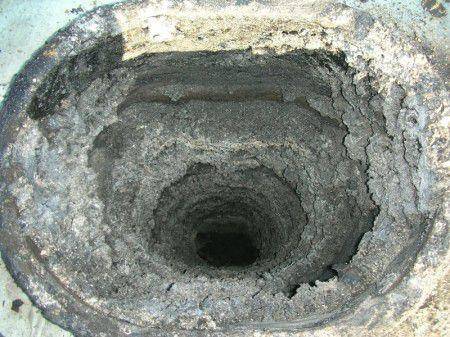
Plaque formed on the walls of the chimney
When using coniferous wood, moreover, water vapor and resin are released, which firmly bind the soot into a hard crust. The lumen of the pipe gradually narrows, the draft deteriorates, and the soot layer becomes thicker and thicker. Sooner or later, the draft disappears completely, and this condition requires immediate cleaning of the chimney.
There are several ways to clean the chimney:
- mechanical, using a ruff;
- chemical, using special tablets or liquids;
- preventive, using traditional or modern combustion catalysts.
Which of the methods is right for you - it will become clear upon further reading of the article.
Frequency of events
 Back draft is one of the signs indicating the need to clean the chimney
Back draft is one of the signs indicating the need to clean the chimney
It is recommended to clean the boiler once a year in the spring after the end of the boiler operation, if it is heated in accordance with the instructions.
The following factors affect the timing of cleaning the chimney:
- Date of the last procedure, how it was carried out and what was the degree of contamination.
- Channel configuration. The number of knees and contours.
- Pipe material. The smoothness of the interior walls.
- The fuel used is coal and raw wood.
- Was the oven used for recycling paper, plastic and synthetic fabrics?
The following signs indicate the need to clean the chimney:
- Weakening traction. Smoke seeping into the room.
- Changing the color of the flame in the firebox from bright orange to red.
- Emitting thick black smoke.
- The appearance of a large amount of dust on the floor, things, interior items.
- The characteristic smell of creosote.
You can check the condition of the pipe visually with a flashlight. To do this, you have to climb onto the roof. If the chimney has bends, a load is lowered inward. By how freely it moves, the level of pollution is calculated.
Existing methods of cleaning the chimney and description of the processes
A means for cleaning chimneys from soot is selected based on an assessment of the thickness and density of the soot layer, the height and shape of the pipe, the availability of available and professional tools, and your own physical capabilities. You should choose a method that, with minimal risk, will bring the highest quality result.
It should be remembered that negligence is fraught with damage to the heating system and injury.
Mechanical method
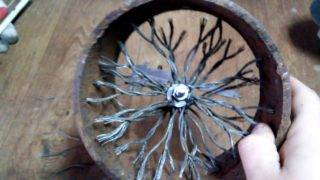 For mechanical cleaning, you need a thick wire brush
For mechanical cleaning, you need a thick wire brush
The most effective method is to remove soot by applying physical effort. This is done with hard-bristled brushes. If the channel is heavily clogged, it is necessary to have several brushes for its gradual expansion. The method of work is simple - the ruff moves up and down, the pile cleans off the soot, which is poured down. Removal of soot can be carried out both from the top and from the bottom, if the chimney design allows.
There are such types of ruffs:
- On a rope with a heavy load under the tool. Here, gravity does some of the work. After the next rise, the device is released and flies through the pipe, capturing carbon deposits.
- On an assembly bar. The device is suitable for removing deposits from straight canals.The sections are wound as they deepen, similar to a drilling rig.
- On a flexible shaft. This is the most versatile device that can be used to clean chimneys of any configuration. The cable is flexible enough to go through knees and contours, and stiff enough not to crumple under load. Thanks to these properties, there is no need to disassemble pipelines of complex shapes.
A prerequisite for work is compliance with the following safety measures:
- the presence of a safety belt;
- non-slip shoes with protectors;
- protective glasses and gloves;
- gauze bandage;
- dry calm weather;
- adequate physiological state.
Folk ways
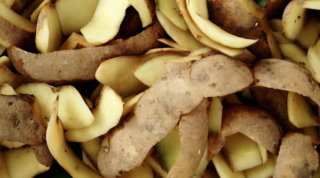 Potato peels soften the soot and cause it to flake off
Potato peels soften the soot and cause it to flake off
There are many effective ways in which you can clean chimneys in a stove using folk remedies. The techniques have been tested for centuries and work perfectly in modern conditions.
Options for cleaning chimneys with folk remedies:
- Boiling water. Soot has a porous structure and absorbs moisture well. The hot liquid is slowly poured into the pipe just before firing. Upon further heating, the absorbed water boils, which leads to the destruction and exfoliation of the plaque.
- Rock salt. When saturated with sodium chloride vapor, the resins harden, crack and fall off from the channel walls. Salt should be poured onto wood or embers. To achieve the desired result, the procedure is recommended to be performed weekly.
- A mixture of saltpeter and copper sulfate. The components are mixed in equal volumes with powdered coal. The agent is added to the working firebox. After exposure to vapors, the deposits become brittle and fall down under their own weight.
- Potato. Chopped tubers and peels are used. They are loaded on top of the burning fuel, and the starch fumes that are released soften the hard build-up. Subsequently, they can be easily removed with a brush.
- Naphthalene. This is an excellent tool, under the influence of which the soot is stratified and carried out by ascending currents. The downside is a persistent pungent smell that remains in the firebox.
- Aspen firewood. This type of wood generates a lot of heat when burned. Use aspen to burn off deposits up to 4 mm thick. If there is more soot, it can explode from strong heat.
Chemicals
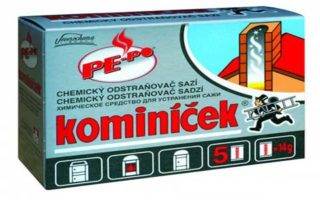 Chemicals change the composition of the soot and cause it to volatilize
Chemicals change the composition of the soot and cause it to volatilize
Household chemicals for cleaning chimneys are efficient, safe and easy to use. Some of the preparations have catalytic properties that cause a change in the composition of the soot and its complete combustion. Other agents act on resins, making them hard and brittle. The products can be purchased at specialized retail outlets and online stores.
Manufacturers offer consumers the following products:
- Granules. The most popular is the Kominichek cleaner produced in the Czech Republic. The pellets are placed directly in the packaging on the burning fuel. Under the influence of the released substances in the soot, a catalytic reaction occurs and it completely burns out.
- Polena "Chimney sweep". They contain components that soften solid deposits. Upon further heating, they evaporate and evaporate with the smoke. All that remains is to drain the condensate from the sump.
- Powders. Stacked directly into the firebox on firewood or coal. During the combustion process, the fuel emits smoke, which changes the chemical composition of the deposits. After that, they either burn out at a low temperature or become brittle.
Manual mechanical cleaning
Of the advantages of this particular cleaning method, it is worth noting completely environmental safety. Various chemicals are not used, and the whole drawback of work comes down only to the fact that there is a danger of falling from a height during work.
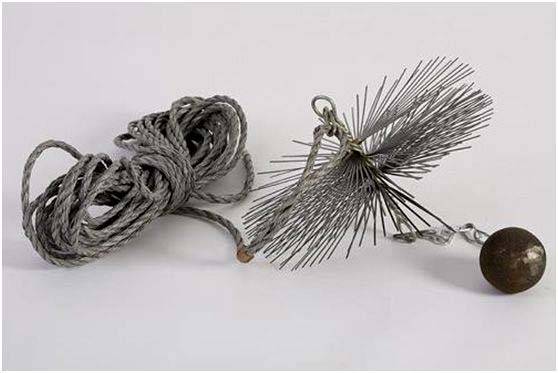 Chimney cleaning tool - rope with core and brush
Chimney cleaning tool - rope with core and brush
Do-it-yourself chimney cleaning will require you to have a certain tool.So, mechanical cleaning of chimneys can be performed using the following devices:
- Giri. Due to its high weight, it penetrates large layers of soot. It is recommended to additionally attach some scratching devices to it in order to increase the efficiency of pipe cleaning.
- Hard brushes. In addition, take care of the long handle so that you can penetrate into distant corners.
- Ruff. By the way, you can make it yourself. Special stainless steel fittings with weights and chains are on sale. Of course, a hand-made brush from a plastic bottle will not replace a professional "adapt", but you will be able to achieve even an insignificant result.
Remember to wear protective equipment when using a brush or brush. Get:- Respirator.
- Glasses.
- Gloves.
- Safety rope.
Prices for the services of professional chimney sweeps
If you use your fireplace more than four times a week, you will need to clean your chimney on a regular basis. This is one of the most important factors in determining the cost of chimney sweep services, since the more often your fireplace or stove is used, the more blockage will form on the walls of the chimney.
In order for cleaning to be as effective as possible, it is advisable to clean both from the house and from the roof.
If you have been using the fireplace for many years and have never been cleaned, the cost of a specialist service can be much more expensive than any subsequent cleaning, as long-term clogging is very difficult to remove.
Approximate prices for chimney sweep services
Prices may vary depending on your region. The table below shows prices for Moscow and the Moscow region.
| Departure of the chimney sweep | 1000 rubles | |
| Chimney initial diagnostics | 6000 rubles (diagnostics) + 7000 rubles (payment for departure) | |
| Mechanical cleaning | 600 - 1000 rubles - per meter of vertical section; 800 - 1000 rubles - per meter of horizontal section. Fireplace cleaning - from 1000 rubles; Cleaning the oven - from 2,000 rubles. Removing additional blockages in the form of nests or foreign objects can cost up to 8,000 rubles, depending on the degree of contamination. |
Dry cleaning by specialists is not carried out and is not strictly recommended for independent use. For an additional fee, a specialist can advise you on how to clean a chimney pipe in a private house yourself.
Always remember that even with proper care you will not be able to avoid contaminating your chimney, it’s just a matter of time. Clean every few months to avoid carbon monoxide poisoning and odor in the room. Despite the apparent effectiveness of home remedies and the use of chemicals, there is no substitute for good mechanical cleaning.
Frequency of cleaning
Regardless of the intensity of use of the stove, the chimney must be prepared for the heating season. It is imperative to remove soot and debris caused by the wind over the summer. Prevention is carried out in late summer or early autumn, depending on the region and weather.
The frequency of intermediate cleanings is influenced by:
- fuel quality;
- chimney design;
- downtime;
- intensity of use.
It is possible to determine the need to clean the exhaust duct from soot in various ways:
- preventive examination;
- by the color of the flame;
- to change the smoke.
You can climb onto the roof with a strong flashlight and see. It will be more convenient if a partner shines into the fireplace from below or a hatch for cleaning in the oven.
When a sufficient amount of air is supplied, the flame is light, slightly yellow. The worse the condition of the chimney, the darker the fire. If it has a rich orange tone, similar to an orange, you need to peel the soot.
Escaping outside, hot air captures soot particles from the furnace. The more it is, the darker the smoke. If there is a gray cloud hanging over the chimney, it's time to tackle the chimney.

Smoke of dark color from the chimney
3 Special means
Along with folk remedies, chemicals are popular to influence the accumulation of soot in the chimney. The use of chemicals is effective for ceramic and stainless steel chimneys. For brick pipes, cleaning with these substances can only be considered preventive.
A positive property of chemical cleaners can be considered the effect on the soot in the boiler, oven or ducts. All funds can be divided into three groups:
- 1. Paper bags with granules, which, without tearing, are stacked on the burning wood. They well clean soot deposits up to 2 mm. The most widespread remedy under the brand name "Kominichek" of Czech production.
- 2. Cleaners in the form of logs, which are placed in a preheated oven on top of the wood. Softens soot making mechanical cleaning easier and easier.
- 3. Packages with powder, produced mainly by Russian manufacturers. The principle of use is the same as for other species.
Cons of special tools:
- the smell in the room after burning them is unpleasant and does not disappear for a long time;
- the price of chemicals is quite high;
- efficiency does not always match the description.
What caused the clogging of chimneys
Chimney clogging occurs due to:
- the use of raw and / or resinous firewood;
- insufficient draft in the chimney and firebox;
- burning garbage in a kiln.
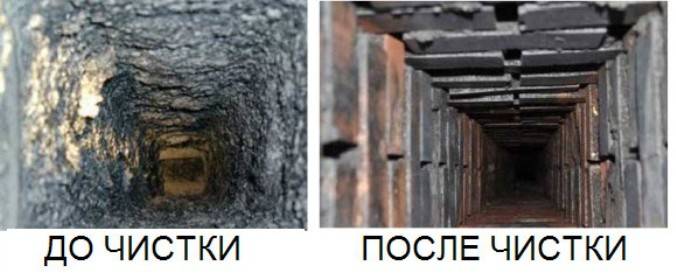
Chimney before and after cleaning
Ideally, the wood in the firebox completely burns out, and only carbon dioxide, water vapor and a minimum amount of fine ash go into the chimney. But with incomplete combustion of wood, resins and large volumes of soot also get into the chimney. Moreover, together with the condensate, all this mixture settles on the walls of the chimney and gradually narrows it. It is these layers that have to be removed regularly by cleaning the chimney.
Features of cleaning stainless steel pipe
The stainless steel pipes stand out for their excellent quality of internal coating. Due to this feature, the condensate flows down unhindered into a special collector. The absence of condensation ensures that soot does not form in the pipes. However, sometimes, for one reason or another, pollution occurs, and in such a case, they need to be eliminated in this way:
- A round brush on a flexible shaft is inserted into the hole in the tee. Carbon deposits are removed by rotating the tool from an electric drill.
- If carbon deposits are persistent, cleaning is carried out by burning out with a blowtorch. This will require the dismantling of the pipe.
The most famous folk methods are effective and safe
In addition to well-known chemicals, alternative methods can be used, which are also very effective in removing soot and other debris from the walls of the chimney. Today we will tell you about the most popular methods. True, it is worth noting that the methods we have given are preventive, So, you can clean the pipes with the help of table salt. The essence of the method is quite simple - add a handful of ordinary salt when burning. When exposed to high temperatures, the salt begins to affect the chemical processes taking place inside the fireplace, as a result of which the soot does not settle on the walls as quickly.
There is another method, which, although effective, is very dangerous. Its main essence is to completely burn off all plaque and soot on the walls. For its implementation, it is necessary to warm up the furnace to the maximum possible temperature - the soot will burn out by itself, leaving no trace on the walls of the chimney. To carry out your plan, take a large amount of aspen firewood (can be replaced with alder). The procedure must be repeated until the stove or fireplace starts to "hum". The main risk of the method is that sparks can fly out during such events - this can easily lead to a fire. In addition, not every fireplace or stove is designed for such high temperatures.
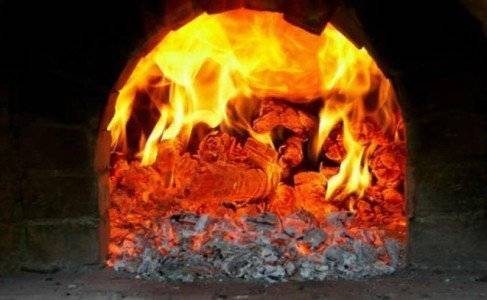
In mild cases, or for prevention purposes, you can use potato peelings. This method relies on the starch contained in the cleanings to interact with the soot, causing it to break down. It is advisable to add a bucket of peelings to a burning fireplace (you can replace them with whole root crops of potatoes). After a while, the soot will simply begin to fall off the wasps of the walls, it is enough just to knock on the chimney with a stick or run a brush over the surface.
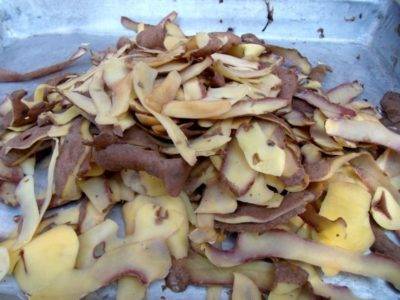
We told you about the importance of cleaning activities and how to clean the chimney in the stove and fireplace as efficiently as possible. We hope our tips will help you remove all plaque and debris that is interfering with the normal operation of your fireplace.
Cleaning with folk methods: both in the snow and in the rain
Today, many are asking the question: how to clean the chimney from soot with folk remedies in the middle of winter, without the need for mechanical cleaning, safely and reliably?
The most famous biological methods (they are usually called folk methods) are peeling with potato peels. This method allows you to avoid rough mechanical removal of soot from the walls of the chimney and is ideal for those areas where the heating season is long enough, because then you do not have to stop the furnace for a long time.
The second method is dry aspen wood, which burns so fast and hot that it burns all the soot in the chimney. But you need to use this method carefully so as not to actually lead to a fire.
The third relatively cheap and reliable method to extend the life of the chimney during the heating season is to sprinkle salt on the wood. With each kindling, the salt binds the soot and prevents it from settling on the walls of the chimney.
You will be surprised, but even the usual, long-known in Russia, chimney cleaning with potato peelings is actually a rather effective method:
Just a quick tip: if you want to peel raw potatoes from your chimney, you need to peel at least half a bucket of it. When the peel is burned, starch will remain from it, which will corrode the soot, and it will simply crumble down. After that, all the ash will just need to be removed from the oven.
Chemical cleaning
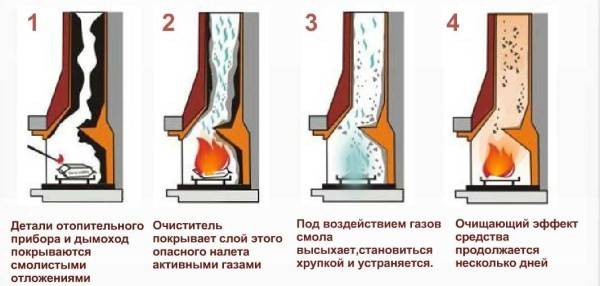
Sodium chloride
Sodium chloride, also known as table salt, is a simple chemical that is easy to find. Place some salt on the fire while it burns. The salt will begin to interact with the water in the burning wood, creating a weak acid that will travel up the chimney and dissolve a small amount of soot.
Use this method with care. Do not use sodium chloride if you have a metal flue gas vent, as acid will corrode if it comes into contact with metal.
Copper sulphate
When choosing an industrial flue gas purifier, one of the most effective ingredients is copper sulphate. This material reacts chemically with the soot and burns it at a lower temperature than usual. Like table salt, copper sulfate works with water to create sulphurous or sulfuric acid, which can damage the inside of your chimney.
While chemical cleaners can prevent soot build-up, the only way to effectively clear the blockage is to manually clean the inside of the pipe with a special brush. Chemical cleaners should never be the only cleaning method. In addition, overuse of chemicals can damage the flue duct, especially metal lined chimneys, which will significantly shorten their service life. Read the instructions carefully before using any chemical cleaner to avoid fire hazards. If the chimney is not working properly and the smoke is blowing back, under no circumstances use chemicals, as this can threaten you with serious poisoning.
Cleaning quality control
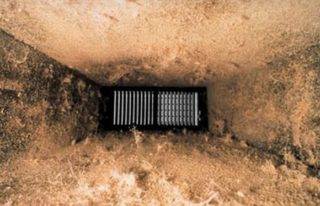 After cleaning, you need to check the chimney by illuminating it with a flashlight
After cleaning, you need to check the chimney by illuminating it with a flashlight
At the end of the pipe cleaning, you need to make sure the quality of the achieved result. Otherwise, undesirable phenomena and repeated work are possible after the heating system has cooled down.
You can check the condition of the chimney in the following ways:
- Visually. The method is only suitable for straight canals without bends and bends. You will need a powerful flashlight that creates a bright beam.
- A round and heavy object, 2-3 cm smaller in diameter than a pipe. This can be a kettlebell, a medicine ball, a ball filled with water, and other items. The quality of cleaning is determined from how freely the object slides along the channel.
- Test furnace. An old newspaper will suffice to determine the pulling force. If the item being burned burns quickly and the process is accompanied by a characteristic roar, the goal of cleaning is achieved.
You can attach a sheet of paper to the opening of the firebox. If it snuggles tight against it and then pulls inward, the job is well done.
How to clean a chimney
If problems are identified, you can independently clean the chimneys using both professional and folk methods. To do this, it is enough to use mechanical devices, special chemicals and just household salt or starch. But much here depends on the degree of clogging and the amount of soot inside. Often, with such cleaning, you have to resort to several methods at once.
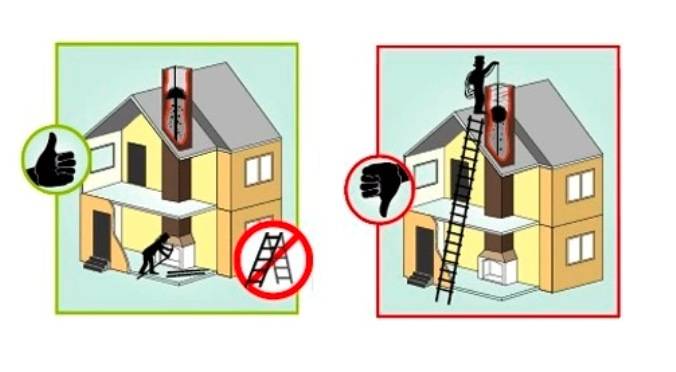
How to properly clean the chimney yourself
Mechanical methods
The most effective way to clean the chimney is mechanical. Chimney sweeps have been using it for centuries, the entire technology of this process has been worked out during this time to the smallest detail. It is possible to clean the chimney by this method both from the bottom of the stove insert (fireplace hearth) and from the top from the roof. But there are nuances.
From above, this method will only be able to clean the vertical section of the chimney duct.

How to clean a chimney with a telescopic brush
Places of pipe bends should be cleaned from soot from inside the house through the firebox or special doors (holes) in the masonry of the stove.
As a tool for mechanical cleaning, the following is used:
- Ruff on a stick or rope with a sinker at the bottom.
- Ruff on a flexible cable (similar analogs are used by plumbers).
- Metal scraper for particularly stubborn soot stains.
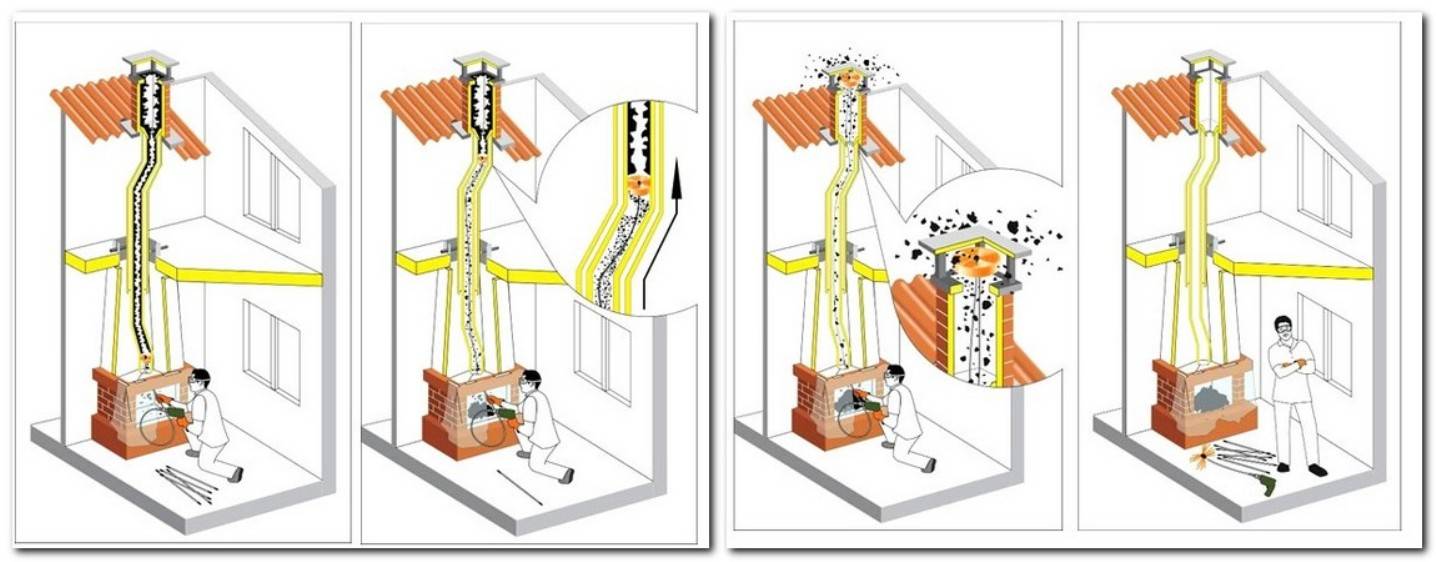
How to clean the chimney from below

How to make a plastic bottle chimney brush
Chemical methods
If you don't want to try on the role of a chimney sweep on the roof, then you can use specialized chemistry. Now there are a lot of products based on copper chloride and ammonium sulfate with phosphorus oxide. At first glance, how to choose an air conditioner for an apartment, it is difficult to understand the range of such chemicals. But everything is quite simple - it is allowed to take any option.

How chemical chimney cleaning works
These chemicals, when burned, emit smoke, which travels up the pipe and looses the soot, causing it to fall down. Then you just need to collect it with a scoop from the bends of the chimney and the stove or fireplace.
Similar chemistry is produced in the form of powders in bags and logs-briquettes. The main nuance of their use is the need for thorough ventilation of the home during cleaning and immediately after.

Chimney cleaners
To clean the chimney with these means is as easy as shelling pears, threw them into the furnace and that's it. However, when they burn, they emit unpleasant and harmful components, which are definitely not worth breathing.
Folk ways to clean the chimney
You can also clean the chimneys of fireplaces, gas boilers and coal-wood stoves using:
- table salt (half a kilo for kindling);
- dry potato peels and just chopped potatoes (a few kilograms at a time);
- powdered naphthalene (apply to logs, gives off a pungent odor);
- aspen firewood.
The principle of operation here is simple - vapors of sodium chloride (salt), starch (from potatoes) and naphthalene corrode the soot, carrying it up into the street with the smoke or forcing it to fall down. With dry aspen, the situation is somewhat different, this wood burns with the highest temperature among all other options for firewood. The dusty soot on the walls of the chimney simply burns out from this heat.
Useful Tips
There are certain rules for using a stove or fireplace that help extend the life of their full-fledged work.
- You should not use firewood obtained from coniferous trees as fuel. The reason for this is the high content of resin in them, the deposits of which remain on the walls of the chimney.
- Do not heat the stove or fireplace with damp wood or wood from recently felled trees. High humidity contributes to increased deposits of soot and water vapor.
- You shouldn't burn various rubbish. This is especially true for products made of plastics and other synthetic materials. Items intended for this must be used as fuel.
- Among all types of firewood, dry deciduous firewood is the best option for a firebox. After the fire, it is advisable to additionally burn a small amount of aspen firewood. They help burn the soot out of the chimney.
Now you know the basic options for cleaning chimneys. It should be remembered that it is necessary to carry out additional inspection during such work. And you should not forget about prevention.
Why is the chimney clogged
 Chimney clogging occurs for a variety of reasons. Often the culprit can be the ingress of a foreign object into the pipe. For example, birds or other animals that bring nesting material with them that completely blocks the smoke exhaust. Excessive build-up of soot (a natural by-product of the combustion process) can also cause clogging. Finally, a large amount of leaves, twigs and other debris can block the chimney.
Chimney clogging occurs for a variety of reasons. Often the culprit can be the ingress of a foreign object into the pipe. For example, birds or other animals that bring nesting material with them that completely blocks the smoke exhaust. Excessive build-up of soot (a natural by-product of the combustion process) can also cause clogging. Finally, a large amount of leaves, twigs and other debris can block the chimney.
Sometimes, improper design during construction can cause further frequent blockages. This is the most difficult cause to eliminate, since in most cases it will not be possible to get rid of it on your own, and contacting qualified specialists can cost a lot of money. Often, to completely eliminate the problem, it is necessary to completely dismantle the stove or fireplace in order to build a new firebox and smoke exhaust system. If you do not have relevant experience and do not know how to clean the chimney, in no case try to do it yourself.
Causes and dangers of stove chimney clogging
When fuel is burned, soot and soot are always formed. Most of it is carried out by thrust. But a certain amount settles on the inner surface of the chimney. The main causes of chimney clogging:
- Weak draft in the riser. Incomplete combustion of fuel leads to heavy soot formation.
- Use of resinous wood firewood. Resins mix with soot, forming a dense mixture that is difficult to remove.
- Incineration of household waste and plastics in a kiln. The substances released during this also contribute to the deposition of soot on the inner walls.
If you do not clean the chimney from soot in time, then its abundant layers will not only worsen the operation of the stove, but can also become a source of danger for people living in the house. This is what happens when large deposits form in the chimney:
- Traction decreases. This leads not only to possible smoke generation, but also to the accelerated formation of new soot.
- In unfavorable weather conditions, a “draft roll over” may occur. In this case, the smoke from the firebox will go inside the room. There is a risk of fire or carbon monoxide poisoning.
- Combustion of soot in the chimney. This will lead to the destruction of the inner walls of the pipe from overheating, and with a large amount of carbon deposits - to a fire.
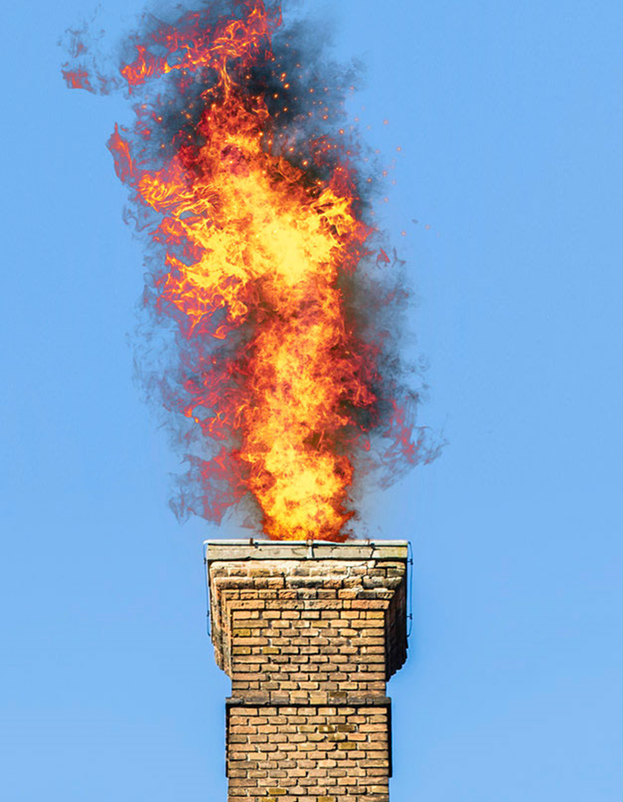 Combustion of soot in the chimney
Combustion of soot in the chimney
In addition to these real dangers, long breaks in chimney cleaning will allow deposits to coke. After that, removing them from the walls will be much more difficult.
Why is it important to clean the chimney in a timely manner?
The safety of those who live in the house directly depends on the state of the chimney. Unlike regular smoke, which has a smell, carbon monoxide is not visible and does not smell. But its long-term effects on the human body can be lethal. In addition, there are other reasons why chimney and chimney cleaning is becoming an important event:
- The operation of the fireplace depends on the state of the chimney. So, in order to ensure normal traction, the area of the pipe lumen must have dimensions that will be greater than a certain design value. The draft of the canal overgrown with soot gradually decreases. Having reached the minimum value, such a gap will not allow the oven to function normally.
- Due to chemical reactions and exposure to high temperatures, the walls of the chimney can begin to collapse over time. A large layer of soot will prevent you from seeing cracks and damage, taking all the necessary measures to eliminate them in time.
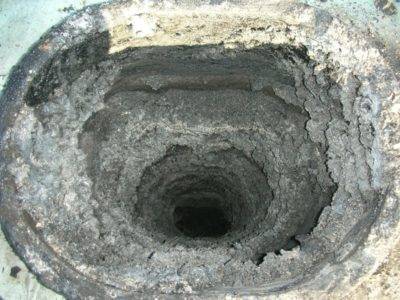
- Burning soot can result in sparks and flames that could cause a fire.
- In addition to soot, small debris and other foreign objects that have fallen into the chimney from the street can interfere with the operation of the chimney.

